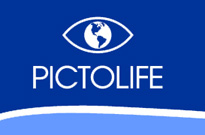|
|
Cnidarians
236 Species found
|
Aurelia aurita |
Distribution |

|

|
Moon jellyfish |

|
Ohrenqualle |

|
Oorkwal |

|
Aurélie |

|
Medusa de cuatro ojos |

|
Pota marina |
|
The tropical Atlantic
The temperate Atlantic
The tropical Pacific
The Red Sea
The Indian Ocean
The Mediterranean |
|
Substrate and environment |
|
Species generally found in the open sea
The species can be found between 0 and 6 Meters
Common species.
|
|
General characteristics of the species |
|
Maximum size of the colony : 0 cm Diameter of the polyp : 400 mm
|
|
Relationship with humans |
|
The species is slightly irritant
|
|
Calvadosia campanulata |
Distribution |
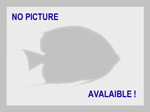
|

|
Stalked jellyfish |

|
|

|
|

|
Lucernaire campanulée |

|
Medusa pedunculada |

|
|
|
The temperate Atlantic |
|
Substrate and environment |
|
The species is generally attached to a reef
The species can be found between 0 and 15 Meters
Uncommon Species
|
|
General characteristics of the species |
|
Diameter of the polyp : 50 mm
Lives in partnership with algae
|
|
Relationship with humans |
|
The species is not irritant
|
|
The species can be confused with other species of similar appearance! |
|
Cassiopea frondosa |
Distribution |
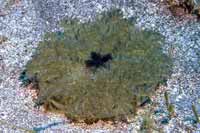
|

|
Upside-down jellyfish |

|
Sandqualle |

|
Zandkwal |

|
Méduse de sable |

|
Medusa invertida |

|
|
|
The tropical Atlantic |
|
Substrate and environment |
|
The species is generally found in a sandy/silty area
The species can be found between 0 and 8 Meters
Common species.
|
|
General characteristics of the species |
|
Diameter of the polyp : 250 mm
Lives in partnership with algae
|
|
Relationship with humans |
|
The species is slightly irritant
|
|
Cassiopea xamachana |
Distribution |
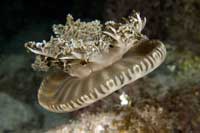
|

|
Mangrove upside-doxn jellyfish |

|
Mangrovenqualle |

|
Mangrovekwal |

|
Cassiopée de mangrove |

|
Medusa invertida de manglares |

|
|
|
The tropical Atlantic |
|
Substrate and environment |
|
The species is generally found in a sandy/silty area
The species can be found between 0 and 15 Meters
Common species.
|
|
General characteristics of the species |
|
Diameter of the polyp : 300 mm
The animal can show variable colouring
Lives in partnership with algae
|
|
Relationship with humans |
|
The species is slightly irritant
|
|
Cassiopea andromeda |
Distribution |

|

|
Upside-down jellyfish |

|
Mangrovequalle |

|
|

|
Cassiopée |

|
Medusa invertida |

|
Medusa cassiopea / andromeda |
|
The tropical Pacific
The Red Sea
The Indian Ocean |
|
Substrate and environment |
|
The species is generally found in a sandy/silty area
The species can be found between 0 and 15 Meters
Uncommon Species
|
|
General characteristics of the species |
|
Maximum size of the colony : 30 cm Diameter of the polyp : 300 mm
Lives in partnership with one or more crustaceans Lives in partnership with algae
|
|
Relationship with humans |
|
The species is slightly irritant
|
|
Cephea cephea |
Distribution |

|

|
Cauliflower jellyfish |

|
Warzenqualle |

|
|

|
Méduse chou-fleur mauve |

|
Medusa corona |

|
Medusa corona |
|
The tropical Atlantic
The tropical Pacific
The Red Sea
The Indian Ocean |
|
Substrate and environment |
|
The species is generally attached to a reef
The species can be found between 0 and 10 Meters
Rare species.
|
|
General characteristics of the species |
|
Maximum size of the colony : 15 cm Diameter of the polyp : 150 mm
|
|
Relationship with humans |
The species is slightly irritant
The species is exploited in the following sector(s) :
- Fishing or commercial aquiculture for food.
|
|
Cestum veneris |
Distribution |

|

|
Venus girdle |

|
Venusgürtel |

|
|

|
Ceinture de Vénus |

|
Cinturón de Venus |

|
|
|
The tropical Atlantic
The temperate Atlantic
The tropical Pacific
The Red Sea
The Indian Ocean
The Mediterranean |
|
Substrate and environment |
|
Species generally found in the open sea
The species can be found between 0 and 5 Meters
Rare species.
|
|
General characteristics of the species |
|
Diameter of the polyp : 1500 mm
|
|
Relationship with humans |
|
The species is not irritant
|
|
Chironex fleckeri |
Distribution |

|

|
Australian box jellyfish |

|
|

|
|

|
Cuboméduse d'Australie |

|
|

|
|
|
The tropical Pacific |
|
Substrate and environment |
|
Species generally found in the open sea
The species can be found between 0 and 30 Meters
Rare species.
|
|
General characteristics of the species |
|
Diameter of the polyp : 300 mm
|
|
Relationship with humans |
|
The species is very irritant
|
|
The species can be confused with other species of similar appearance! |
|
Chiropsalmus quadrumanus |
Distribution |

|

|
Four-handed box jellyfish |

|
|

|
|

|
|

|
|

|
|
|
The tropical Atlantic
The tropical Pacific |
|
Substrate and environment |
|
Species generally found in the open sea
The species can be found between 0 and 55 Meters
Uncommon Species
|
|
General characteristics of the species |
|
Maximum size of the colony : 14 cm Diameter of the polyp : 140 mm
|
|
Relationship with humans |
|
Contact with the animal can result in death
|
|
Chrysaora quinquecirrha |
Distribution |
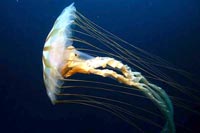
|

|
Sea nettle |

|
Kompassqualle |

|
Zeebrandnetel |

|
Ortie de mer |

|
Ortiga de mar;Agua mala |

|
|
|
The tropical Atlantic
The temperate Atlantic
The tropical Pacific |
|
Substrate and environment |
|
Species generally found in the open sea
The species can be found between 0 and 25 Meters
Uncommon Species
|
|
General characteristics of the species |
|
Maximum size of the colony : 100 cm Diameter of the polyp : 25 mm
|
|
Relationship with humans |
|
The species is slightly irritant
|
|
Chrysaora hysoscella |
Distribution |
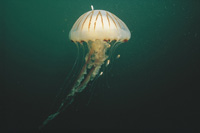
|

|
Compass jellyfish |

|
Kompassqualle |

|
Kompaskwal |

|
Méduse rayonnée |

|
Aguamar |

|
Medusa bruna |
|
The temperate Atlantic
The Mediterranean |
|
Substrate and environment |
|
Species generally found in the open sea
The species can be found between 0 and 20 Meters
Uncommon Species
|
|
General characteristics of the species |
|
Diameter of the polyp : 350 mm
Lives in partnership with one or more fishes
|
|
Relationship with humans |
|
The species is irritant
|
|
Chrysaora lactea |
Distribution |

|
|
The tropical Atlantic |
|
Substrate and environment |
|
Species generally found in the open sea
The species can be found between 0 and 45 Meters
Uncommon Species
|
|
General characteristics of the species |
|
Diameter of the polyp : 250 mm
Lives in partnership with one or more fishes
|
|
Relationship with humans |
|
The species is slightly irritant
|
|
Cotylorhiza tuberculata |
Distribution |
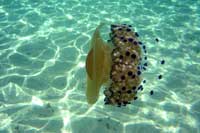
|

|
Egg Jellyfish |

|
Knollen |

|
Spiegeleikwal |

|
Méduse œuf au plat |

|
Aguacuajada |

|
Cassiopea |
|
The Mediterranean |
|
Substrate and environment |
|
Species generally found in the open sea
The species can be found between 0 and 1 Meters
Uncommon Species
|
|
General characteristics of the species |
|
Diameter of the polyp : 350 mm
Lives in partnership with algae
|
|
Relationship with humans |
|
The species is slightly irritant
|
|
Cyanea lamarcki |
Distribution |

|

|
Blue hair jellyfish |

|
Blaue Nesselqualle |

|
Blauwe haarkwal |

|
Cyanée de Lamarck |

|
Medusa orticante azul |

|
|
|
The temperate Atlantic |
|
Substrate and environment |
|
Species generally found in the open sea
The species can be found between 0 and 10 Meters
Common species.
|
|
General characteristics of the species |
|
Diameter of the polyp : 300 mm
|
|
Relationship with humans |
|
The species is very irritant
|
|
Leucothea multicornis |
Distribution |

|

|
Warty comb jelly |

|
Rippenqualle |

|
|

|
Leucothéa |

|
Ctenóforo |

|
|
|
The tropical Atlantic
The temperate Atlantic
The Mediterranean |
|
Substrate and environment |
|
Generally in an area where there is a current
The species can be found between 0 and 5 Meters
Rare species.
|
|
General characteristics of the species |
|
Diameter of the polyp : 200 mm
|
|
Relationship with humans |
|
The species is not irritant
|
|
Linuche unguiculata |
Distribution |

|

|
Sea thimble |

|
Fingerhutqualle |

|
Zeevingerhoed |

|
Méduse dé à coudre |

|
Dedal de mar |

|
|
|
The tropical Atlantic
The tropical Pacific
The Red Sea
The Indian Ocean |
|
Substrate and environment |
|
Species generally found in the open sea
The species can be found between 0 and 3 Meters
Uncommon Species
|
|
General characteristics of the species |
|
Diameter of the polyp : 20 mm
|
|
Relationship with humans |
|
The species is slightly irritant
|
|
Lucernaria quadricornis |
Distribution |

|

|
Horned stalked jellyfish |

|
Vierhorn Becherqualle |

|
|

|
Lucernaire à quatre cornes |

|
|

|
|
|
The temperate Atlantic
The Mediterranean |
|
Substrate and environment |
|
The species is generally attached to a reef
The species can be found between 0 and 500 Meters
Rare species.
|
|
General characteristics of the species |
|
Diameter of the polyp : 75 mm
Lives in partnership with algae
|
|
Relationship with humans |
|
The species is not irritant
|
|
The species can be confused with other species of similar appearance! |
|
Lychnorhiza lucerna |
Distribution |

|
|
The tropical Atlantic |
|
Substrate and environment |
|
Species generally found in the open sea
The species can be found between 0 and 40 Meters
Uncommon Species
|
|
General characteristics of the species |
|
Maximum size of the colony : 0 cm Diameter of the polyp : 450 mm
Lives in partnership with one or more fishes Lives in partnership with one or more crustaceans
|
|
Relationship with humans |
|
The species is irritant
|
|
Mastigias papua |
Distribution |

|

|
Spotted jelly |

|
|

|
|

|
Mastigias papua |

|
|

|
|
|
The tropical Pacific
The Indian Ocean |
|
Substrate and environment |
|
Species generally found in the open sea
The species can be found between 0 and 10 Meters
Rare species.
|
|
General characteristics of the species |
|
Diameter of the polyp : 600 mm
Lives in partnership with one or more fishes Lives in partnership with algae
|
|
Relationship with humans |
|
The species is irritant
|
|
Mnemiopsis leidyi |
Distribution |

|
|
The tropical Atlantic |
|
Substrate and environment |
|
Species generally found in the open sea
The species can be found between 0 and 50 Meters
Common species.
|
|
General characteristics of the species |
|
Maximum size of the colony : 0 cm Diameter of the polyp : 120 mm
Animal with fast growth
|
|
Relationship with humans |
|
The species is irritant
|
|
Pelagia noctiluca |
Distribution |

|

|
Pink jellyfish |

|
Leuchtqualle |

|
Parelkwal |

|
Pélagie |

|
Medusa luminiscente |

|
Medusa noctiluca |
|
The tropical Atlantic
The temperate Atlantic
The tropical Pacific
The Red Sea
The Indian Ocean
The Mediterranean |
|
Substrate and environment |
|
Species generally found in the open sea
The species can be found between 0 and 1400 Meters
Common species.
|
|
General characteristics of the species |
|
Maximum size of the colony : 17 cm Diameter of the polyp : 170 mm
|
|
Relationship with humans |
|
The species is very irritant
|
|
Phyllorhiza Punctata |
Distribution |

|

|
Australian Spotted Jellyfish |

|
|

|
|

|
Méduse constellée |

|
|

|
|
|
The tropical Atlantic
The tropical Pacific
The Red Sea
The Indian Ocean
The Mediterranean |
|
Substrate and environment |
|
Species generally found in the open sea
The species can be found between 0 and 40 Meters
Uncommon Species
|
|
General characteristics of the species |
|
Diameter of the polyp : 700 mm
|
|
Relationship with humans |
|
The species is slightly irritant
|
|
Physalia physalis |
Distribution |
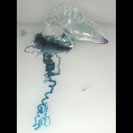
|

|
Portuguese man-of-war |

|
Portugiesische Galeere |

|
Portugees oorlogsschip |

|
Physalie |

|
Navío portugués |

|
Caravella portoghese |
|
The tropical Atlantic
The temperate Atlantic
The Mediterranean |
|
Substrate and environment |
|
Species generally found in the open sea
The animal is found on the surface
Rare species.
|
|
General characteristics of the species |
|
Maximum size of the colony : 1000 cm Diameter of the polyp : 200 mm
|
|
Relationship with humans |
|
The species is very irritant
|
|
Rhizostoma pulmo |
Distribution |
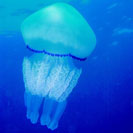
|

|
Rhizostome |

|
Blumenkohlqualle |

|
Longkwal |

|
Rhizostome |

|
Aguamar |

|
Polmone di mare |
|
The tropical Atlantic
The temperate Atlantic
The tropical Pacific
The Indian Ocean
The Mediterranean |
|
Substrate and environment |
|
Species generally found in the open sea
The species can be found between 0 and 10 Meters
Uncommon Species
|
|
General characteristics of the species |
|
Diameter of the polyp : 1000 mm
The animal can show variable colouring
Lives in partnership with one or more fishes Lives in partnership with one or more crustaceans Lives in partnership with algae
|
|
Relationship with humans |
|
The species is slightly irritant
|
|
Stomolophus meleagris |
Distribution |
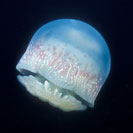
|

|
Cannonball jelly |

|
Kanonenkugel-Qualle |

|
Kanonskogelkwal |

|
Méduse montgolfière |

|
Medusa bala de cañón |

|
|
|
The tropical Atlantic
The tropical Pacific |
|
Substrate and environment |
|
Species generally found in the open sea
The species can be found between 0 and 6 Meters
Uncommon Species
|
|
General characteristics of the species |
|
Diameter of the polyp : 180 mm
The animal can show variable colouring
Lives in partnership with one or more fishes Lives in partnership with one or more crustaceans
|
|
Relationship with humans |
The species is not irritant
The species is exploited in the following sector(s) :
- Fishing or commercial aquiculture for food.
|
|
Thysanostoma loriferum |
Distribution |

|

|
Purple jellyfish |

|
Rosa Zigarrenqualle |

|
|

|
Méduse violette |

|
Medusa frambuesa |

|
Medusa tisanostoma |
|
The tropical Pacific
The Red Sea
The Indian Ocean |
|
Substrate and environment |
|
Species generally found in the open sea
The species can be found between 0 and 1000 Meters
Rare species.
|
|
General characteristics of the species |
|
Maximum size of the colony : 20 cm Diameter of the polyp : 200 mm
Lives in partnership with one or more fishes
|
|
Relationship with humans |
|
The species is slightly irritant
|
|
Acabaria biserialis |
Distribution |

|

|
Red sea fan |

|
Gitter - Gorgonie/Verzweigte Knotenkoralle |

|
|

|
Gorgone éventail rouge |

|
Abanico de mar reticulado |

|
Gorgonia striata |
|
The Red Sea |
|
Substrate and environment |
|
The species is generally attached to a reef
Generally in an area where there is a current
The species can be found between 10 and 60 Meters
Uncommon Species
Endemic species.
|
|
General characteristics of the species |
|
Maximum size of the colony : 80 cm
|
|
Relationship with humans |
|
The species is not irritant
|
|
The species can be confused with other species of similar appearance! |
|
Alcyonium acaule |
Distribution |

|

|
Mediterranean sea-finger |

|
Mittelmeer-Meerhand |

|
Middellandse Zee-dodemansduim |

|
Alcyon méditerranéen |

|
Mano de muerte mediterraneo |

|
Mano di San Piero mediterraneo |
|
The Mediterranean |
|
Substrate and environment |
|
The species is generally attached to a reef
Often in a cavity or under an overhang
The species can be found between 12 and 135 Meters
Uncommon Species
Endemic species.
|
|
General characteristics of the species |
|
Maximum size of the colony : 20 cm Diameter of the polyp : 5 mm
The animal can show variable colouring Animal with slow growth
|
|
Relationship with humans |
|
The species is not irritant
|
|
The species can be confused with other species of similar appearance! |
|
Alcyonium digitatum |
Distribution |

|

|
Dead men’s fingers |

|
Bastardschwamm |

|
Dodemansduim |

|
Alcyon jaune |

|
Mano de muerte |

|
Mano di morto |
|
The temperate Atlantic |
|
Substrate and environment |
|
The species is generally attached to a reef
Generally in an area where there is a current
The species can be found between 1 and 100 Meters
Common species.
|
|
General characteristics of the species |
|
Maximum size of the colony : 20 cm Diameter of the polyp : 5 mm
The animal can show variable colouring Animal with slow growth
|
|
Relationship with humans |
|
The species is not irritant
|
|
The species can be confused with other species of similar appearance! |
|
Alcyonium glomeratum |
Distribution |

|

|
Red dead man’s fingers |

|
Rote Meerhand |

|
Rode Dodemansduim |

|
Alcyon rouge |

|
Mano de muerto roja |

|
|
|
The temperate Atlantic |
|
Substrate and environment |
|
The species is generally attached to a reef
Often in a cavity or under an overhang
The species can be found between 10 and 50 Meters
Rare species.
|
|
General characteristics of the species |
|
Maximum size of the colony : 20 cm
|
|
Relationship with humans |
|
The species is not irritant
|
|
The species can be confused with other species of similar appearance! |
|
Annella mollis |
Distribution |

|

|
Giant sea fan |

|
Rotmeer Riesengorgonie |

|
|

|
Gorgone géante |

|
Gorgonia gigante del Mar Rojo |

|
Ventaglio di mare gigante |
|
The tropical Pacific
The Red Sea
The Indian Ocean |
|
Substrate and environment |
|
The species is generally attached to a reef
Generally in an area where there is a current
The species can be found between 10 and 50 Meters
Uncommon Species
|
|
General characteristics of the species |
|
Maximum size of the colony : 200 cm
|
|
Relationship with humans |
The species is not irritant
The species is exploited in the following sector(s) :
Used in the clothing, footwear or crafts industries for the manufacture of articles (jewellery, etc.).
|
|
Briareum asbestinum |
Distribution |
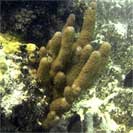
|

|
Corky sea finger |

|
Seefinger |

|
Zeevingers |

|
Doigts de mer |

|
Dedos de mar |

|
Alcionario |
|
The tropical Atlantic |
|
Substrate and environment |
|
The species is generally attached to a reef
The species can be found between 0 and 35 Meters
Common species.
|
|
General characteristics of the species |
|
Maximum size of the colony : 60 cm
Lives in partnership with algae
|
|
Relationship with humans |
The species is not irritant
The species is exploited in the following sector(s) :
- Aquarium enthusiasts.
|
|
Carijoa riiseii |
Distribution |

|

|
White telesto;snowflake coral |

|
Weisser Telesto |

|
Witte telesto |

|
Télesto blanc |

|
Telesto blanco |

|
|
|
The tropical Atlantic
The tropical Pacific
The Indian Ocean |
|
Substrate and environment |
|
The species is generally attached to a reef
Generally in an area where there is a current
The species can be found between 0 and 100 Meters
Uncommon Species
|
|
General characteristics of the species |
|
Maximum size of the colony : 30 cm
Lives in partnership with one or more crustaceans
|
|
Relationship with humans |
|
The species is slightly irritant
|
|
Corallium rubrum |
Distribution |
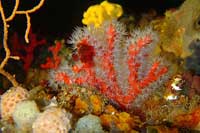
|

|
Red Coral |

|
Luft koralle |

|
Bloedkoraal |

|
Corail rouge |

|
Coral rojo |

|
Corallo rosso |
|
The Mediterranean |
|
Substrate and environment |
|
The species is generally attached to a reef
Often in a cavity or under an overhang
The species can be found between 2 and 400 Meters
Uncommon Species
Endemic species.
|
|
General characteristics of the species |
|
Maximum size of the colony : 30 cm Diameter of the polyp : 5 mm
Animal with slow growth
|
|
Relationship with humans |
The species is not irritant
The species is exploited in the following sector(s) :
Used in the clothing, footwear or crafts industries for the manufacture of articles (jewellery, etc.).
|
|
Ctenocella pectinata |
Distribution |

|

|
Lyre sea fan |

|
|

|
|

|
Gorgone lyre |

|
|

|
|
|
The tropical Pacific |
|
Substrate and environment |
|
The species is generally attached to a reef
The species can be found between 5 and 35 Meters
Uncommon Species
|
|
General characteristics of the species |
|
Maximum size of the colony : 150 cm
|
|
Relationship with humans |
|
The species is not irritant
|
|
Dendronephthya hemprichi |
Distribution |

|

|
Prickly alcyonarian |

|
Stachelige Pracht-koralle |

|
|

|
Alcyonaire translucide |

|
|

|
|
|
The tropical Pacific
The Red Sea
The Indian Ocean |
|
Substrate and environment |
|
The species is generally attached to a reef
The species can be found between 10 and 100 Meters
Very common species.
|
|
General characteristics of the species |
|
Maximum size of the colony : 70 cm
The animal can show variable colouring
|
|
Relationship with humans |
The species is not irritant
The species is exploited in the following sector(s) :
- Aquarium enthusiasts.
|
|
The species can be confused with other species of similar appearance! |
|
Ellisella elongata |
Distribution |

|

|
Long sea whip |

|
Lange Seepeitsche |

|
Zeezweep |

|
Gorgone balai étirée |

|
Látigo de mar |

|
|
|
The tropical Atlantic
The temperate Atlantic
The tropical Pacific
The Mediterranean |
|
Substrate and environment |
|
The species is generally attached to a reef
The species can be found between 20 and 500 Meters
Uncommon Species
|
|
General characteristics of the species |
|
Maximum size of the colony : 150 cm
|
|
Relationship with humans |
|
The species is not irritant
|
|
The species can be confused with other species of similar appearance! |
|
Eunicea sp |
Distribution |
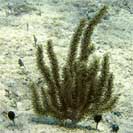
|

|
Knobby sea rod |

|
Knorrige See-Rute |

|
Knobbelgorgoon |

|
Gorgone noueuse |

|
Vara de mar |

|
|
|
The tropical Atlantic |
|
Substrate and environment |
|
The species can be found between 0 and 35 Meters
Common species.
|
|
General characteristics of the species |
|
Maximum size of the colony : 100 cm
The animal can show variable colouring
|
|
Relationship with humans |
|
The species is not irritant
|
|
The species can be confused with other species of similar appearance! |
|
Eunicella cavolinii |
Distribution |
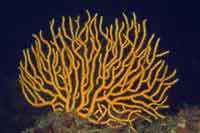
|

|
Yellow gorgonian |

|
Gelbe Fächerkoralle |

|
Geel hoornkoraal |

|
Gorgone jaune |

|
Gorgonia amarilla |

|
Gorgonia gallia |
|
The Mediterranean |
|
Substrate and environment |
|
The species is generally attached to a reef
The species can be found between 5 and 150 Meters
Very common species.
Endemic species.
|
|
General characteristics of the species |
|
Maximum size of the colony : 50 cm Diameter of the polyp : 3 mm
Animal with slow growth
|
|
Relationship with humans |
|
The species is not irritant
|
|
Eunicella singularis |
Distribution |
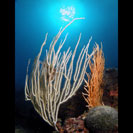
|

|
White gorgonian |

|
weiße Fächerkoralle |

|
Wit hoornkoraal |

|
Gorgone blanche |

|
Gorgonia blanca |

|
Gorgonia bianca |
|
The Mediterranean |
|
Substrate and environment |
|
The species is generally attached to a reef
The species can be found between 5 and 60 Meters
Common species.
Endemic species.
|
|
General characteristics of the species |
|
Maximum size of the colony : 60 cm Diameter of the polyp : 4 mm
Animal with medium growth
|
|
Relationship with humans |
The species is not irritant
The species is exploited in the following sector(s) :
Used in the clothing, footwear or crafts industries for the manufacture of articles (jewellery, etc.).
|
|
Eunicella verrucosa |
Distribution |

|

|
Pink sea fan |

|
Warzige Fächerkoralle |

|
Zeewaaier |

|
Gorgone verruqueuse |

|
Gorgonia blanca |

|
Gorgonia verrucosa |
|
The temperate Atlantic
The Mediterranean |
|
Substrate and environment |
|
The species is generally attached to a reef
The species can be found between 10 and 200 Meters
Common species.
|
|
General characteristics of the species |
|
Maximum size of the colony : 80 cm
The animal can show variable colouring Animal with slow growth
|
|
Relationship with humans |
|
The species is not irritant
The species is classified asVulnerable
|
|
The species can be confused with other species of similar appearance! |
|
Gerardia macaronesica |
Distribution |

|

|
Macaronesian bushy anemone |

|
Strauchanemone |

|
|

|
Anémone buissonnante macaronésienne |

|
Actinia arbol de macaronesia |

|
|
|
The temperate Atlantic |
|
Substrate and environment |
|
The species is generally attached to a reef
Generally in an area where there is a current
The species can be found between 10 and 120 Meters
Uncommon Species
Endemic species.
|
|
General characteristics of the species |
|
Maximum size of the colony : 100 cm Diameter of the polyp : 30 mm
|
|
Relationship with humans |
|
The species is not irritant
|
|
Gorgonia ventalina |
Distribution |
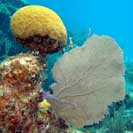
|

|
Common sea fan |

|
Gemeine Gorgonie |

|
Zeewaaier |

|
Eventail de mer commun |

|
Abanico común |

|
Gorgonia a ventaglio |
|
The tropical Atlantic |
|
Substrate and environment |
|
The species is generally attached to a reef
Generally in an area where there is a current
The species can be found between 1 and 30 Meters
Common species.
|
|
General characteristics of the species |
|
Maximum size of the colony : 180 cm
The animal can show variable colouring
Lives in partnership with algae
|
|
Relationship with humans |
The species is not irritant
The species is exploited in the following sector(s) :
- Aquarium enthusiasts.
|
|
The species can be confused with other species of similar appearance! |
|
Gorgonia flabellum |
Distribution |

|

|
Venus sea fan, Bahamian sea fan |

|
Venusfächer |

|
Venus-zeewaaier |

|
Eventail de Vénus |

|
Abanico de Venus |

|
Violacea gorgonia a ventaglio |
|
The tropical Atlantic |
|
Substrate and environment |
|
The species is generally attached to a reef
Generally in an area where there is a current
The species can be found between 1 and 35 Meters
Common species.
|
|
General characteristics of the species |
|
Maximum size of the colony : 100 cm
The animal can show variable colouring
Lives in partnership with algae
|
|
Relationship with humans |
The species is not irritant
The species is exploited in the following sector(s) :
- Aquarium enthusiasts.
|
|
The species can be confused with other species of similar appearance! |
|
Gorgonia mariae |
Distribution |

|

|
wide-mesh sea fan |

|
Große Masche Gorgonie |

|
Grote maas zeewaaier |

|
Eventail de mer à grandes mailles |

|
Abanico a gran malla |

|
|
|
The tropical Atlantic |
|
Substrate and environment |
|
The species is generally attached to a reef
The species can be found between 1 and 50 Meters
Uncommon Species
|
|
General characteristics of the species |
|
Maximum size of the colony : 30 cm
The animal can show variable colouring
Lives in partnership with algae
|
|
Relationship with humans |
The species is not irritant
The species is exploited in the following sector(s) :
- Aquarium enthusiasts.
|
|
Iciligorgia schrammi |
Distribution |
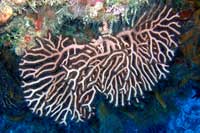
|

|
Deepwater sea fan |

|
Tiefsee-Gorgonie |

|
Rossige diepwatergorgoon |

|
Gorgone rousse des tombants |

|
Gorgonia del alto |

|
|
|
The tropical Atlantic |
|
Substrate and environment |
|
The species is generally attached to a reef
Generally in an area where there is a current
The species can be found between 10 and 400 Meters
Common species.
|
|
General characteristics of the species |
|
Maximum size of the colony : 120 cm
The animal can show variable colouring
Lives in partnership with algae
|
|
Relationship with humans |
|
The species is not irritant
|
|
Junceella juncea |
Distribution |

|

|
Delicate sea whip |

|
Peitschen - Gorgonie |

|
Zweepkoraal |

|
Fouet d emer |

|
Coral latigo |

|
Gorgonia rossa |
|
The Red Sea
The Indian Ocean |
|
Substrate and environment |
|
The species is generally found in a sandy/silty area
The species can be found between 10 and 30 Meters
Common species.
|
|
General characteristics of the species |
|
Maximum size of the colony : 200 cm
Lives in partnership with algae
|
|
Relationship with humans |
The species is not irritant
The species is exploited in the following sector(s) :
- Chemistry/pharmacy.
|
|
The species can be confused with other species of similar appearance! |
|
Leptogorgia ruberrima |
Distribution |

|

|
Red Sea Fan |

|
Rote Hornkoralle |

|
|

|
Gorgone rouge |

|
Gorgonia Roja |

|
|
|
The temperate Atlantic
The Mediterranean |
|
Substrate and environment |
|
The species is generally attached to a reef
Generally in an area where there is a current
The species can be found between 25 and 200 Meters
Common species.
Endemic species.
|
|
General characteristics of the species |
|
Maximum size of the colony : 50 cm
|
|
Relationship with humans |
|
The species is not irritant
|
|
Leptogorgia viminalis |
Distribution |

|

|
Yellow Sea Fan |

|
Gelbe Hornkoralle |

|
|

|
Gorgone Jaune |

|
Gorgonia Amarrilla |

|
|
|
The temperate Atlantic
The Mediterranean |
|
Substrate and environment |
|
The species is generally attached to a reef
Generally in an area where there is a current
The species can be found between 10 and 50 Meters
Common species.
Endemic species.
|
|
General characteristics of the species |
|
Maximum size of the colony : 80 cm
|
|
Relationship with humans |
|
The species is not irritant
|
|
Litophyton arboreum |
Distribution |

|

|
brocoli soft coral |

|
Brokkoli-Lederkoralle |

|
|

|
Alcyonaire arborescent |

|
|

|
|
|
The tropical Pacific
The Red Sea
The Indian Ocean |
|
Substrate and environment |
|
The species is generally attached to a reef
The species can be found between 5 and 25 Meters
Very common species.
|
|
General characteristics of the species |
|
Maximum size of the colony : 80 cm
The animal can show variable colouring
Lives in partnership with algae
|
|
Relationship with humans |
The species is not irritant
The species is exploited in the following sector(s) :
- Aquarium enthusiasts.
|
|
The species can be confused with other species of similar appearance! |
|
Melithaea sp. |
Distribution |

|

|
Knotted Fan Coral |

|
Knoten-Gorgonie |

|
|

|
Gorgone à noeuds |

|
|

|
|
|
The tropical Pacific
The Indian Ocean |
|
Substrate and environment |
|
The species is generally attached to a reef
The species can be found between 3 and 45 Meters
Uncommon Species
|
|
General characteristics of the species |
|
Maximum size of the colony : 100 cm
The animal can show variable colouring
|
|
Relationship with humans |
The species is not irritant
The species is exploited in the following sector(s) :
- Aquarium enthusiasts.
Used in the clothing, footwear or crafts industries for the manufacture of articles (jewellery, etc.).
|
|
Muriceopsis flavida |
Distribution |

|

|
Rough sea plume |

|
Unregelmäßig Gefiederte Gorgonie |

|
Onregelmatige gevederde gorgoon |

|
Gorgone plume irrégulière |

|
Gorgonia pluma irregular |

|
|
|
The tropical Atlantic |
|
Substrate and environment |
|
The species is generally attached to a reef
The species can be found between 1 and 35 Meters
Common species.
|
|
General characteristics of the species |
|
Maximum size of the colony : 80 cm
The animal can show variable colouring
|
|
Relationship with humans |
|
The species is not irritant
|
|
Muriceopsis sulphurea |
Distribution |

|
|
The tropical Atlantic |
|
Substrate and environment |
|
The species is generally attached to a reef
The species can be found between 0 and 12 Meters
Uncommon Species
|
|
General characteristics of the species |
|
Maximum size of the colony : 40 cm
Lives in partnership with algae
|
|
Relationship with humans |
|
The species is not irritant
|
|
The species can be confused with other species of similar appearance! |
|
Paramuricea clavata |
Distribution |
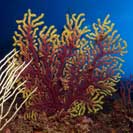
|

|
Purple gorgonian |

|
Rote Gorgonie |

|
Roodpaars hoornkoraal |

|
Gorgone pourpre |

|
Gorgonia roja |

|
Gorgonia rossa |
|
The Mediterranean |
|
Substrate and environment |
|
The species is generally attached to a reef
The species can be found between 7 and 110 Meters
Common species.
Endemic species.
|
|
General characteristics of the species |
|
Maximum size of the colony : 100 cm Diameter of the polyp : 8 mm
The animal can show variable colouring Animal with medium growth
|
|
Relationship with humans |
|
The species is not irritant
|
|
Pennatula phosphorea |
Distribution |

|

|
Sea-pen |

|
Seefeder |

|
Zeever |

|
Plume de mer |

|
Pennatula |

|
Pennatula |
|
The temperate Atlantic |
|
Substrate and environment |
|
The species is generally found in a sandy/silty area
The species can be found between 10 and 100 Meters
Rare species.
|
|
General characteristics of the species |
|
Maximum size of the colony : 25 cm
|
|
Relationship with humans |
|
The species is not irritant
|
|
Phyllogorgia dilatata |
Distribution |

|
|
|
|
Substrate and environment |
|
The species is generally attached to a reef
The species can be found between 0 and 28 Meters
Very common species.
Endemic species.
|
|
General characteristics of the species |
|
Maximum size of the colony : 50 cm
Lives in partnership with algae
|
|
Relationship with humans |
The species is not irritant
The species is exploited in the following sector(s) :
- Chemistry/pharmacy.
|
|
Plexaura flexuosa |
Distribution |

|

|
Bent sea rod |

|
Mehrfach Gegabelte Gorgonie |

|
Gegaffelde gorgoon |

|
Gorgone dichotome |

|
Varilla de mar |

|
|
|
The tropical Atlantic |
|
Substrate and environment |
|
The species is generally attached to a reef
The species can be found between 1 and 50 Meters
Common species.
|
|
General characteristics of the species |
|
Maximum size of the colony : 40 cm Diameter of the polyp : 0 mm
The animal can show variable colouring
Lives in partnership with algae
|
|
Relationship with humans |
The species is not irritant
The species is exploited in the following sector(s) :
- Aquarium enthusiasts.
|
|
The species can be confused with other species of similar appearance! |
|
Plexaura homomalla |
Distribution |

|

|
Black sea rod |

|
Schwarze See-Rute |

|
Zwarte gorgoon |

|
Gorgone arborescente noire |

|
Gorgonia negra |

|
|
|
The tropical Atlantic |
|
Substrate and environment |
|
The species is generally attached to a reef
The species can be found between 0 and 70 Meters
Common species.
|
|
General characteristics of the species |
|
Maximum size of the colony : 50 cm
|
|
Relationship with humans |
The species is not irritant
The species is exploited in the following sector(s) :
- Chemistry/pharmacy.
|
|
Plexaurella spp. |
Distribution |
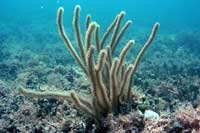
|

|
Slit-pore sea rod |

|
Schlitzporige See-Rute |

|
Spleetporie-gorgoon |

|
Gorgone à pores en forme de fente |

|
Gorgonia de poros rasgados |

|
|
|
The tropical Atlantic |
|
Substrate and environment |
|
The species is generally attached to a reef
The species can be found between 1 and 55 Meters
Common species.
|
|
General characteristics of the species |
|
Maximum size of the colony : 100 cm
The animal can show variable colouring
Lives in partnership with algae
|
|
Relationship with humans |
The species is not irritant
The species is exploited in the following sector(s) :
- Aquarium enthusiasts.
|
|
The species can be confused with other species of similar appearance! |
|
Plexaurella regia |
Distribution |

|
|
The tropical Atlantic |
|
Substrate and environment |
|
The species is generally attached to a reef
The species can be found between 0 and 20 Meters
Uncommon Species
|
|
General characteristics of the species |
|
Maximum size of the colony : 60 cm
Lives in partnership with one or more crustaceans Lives in partnership with algae
|
|
Relationship with humans |
|
The species is not irritant
|
|
The species can be confused with other species of similar appearance! |
|
Pseudoplexaura spp |
Distribution |

|

|
Porous sea rod |

|
Porige See-Rute |

|
Poreuze gorgoon |

|
Gorgone poreuse |

|
Gorgonia porosa |

|
Gorgonia caraibica |
|
The tropical Atlantic |
|
Substrate and environment |
|
The species is generally attached to a reef
The species can be found between 1 and 100 Meters
Common species.
|
|
General characteristics of the species |
|
Maximum size of the colony : 225 cm
The animal can show variable colouring
Lives in partnership with algae
|
|
Relationship with humans |
The species is not irritant
The species is exploited in the following sector(s) :
- Aquarium enthusiasts.
|
|
Pseudopterogorgia acerosa |
Distribution |
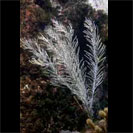
|

|
Purple sea plume |

|
Trockener Federbusch |

|
Droge zeepluim |

|
Plume de mer sèche |

|
Pluma de mar seca |

|
Gorgonie piumosa |
|
The tropical Atlantic |
|
Substrate and environment |
|
The species is generally attached to a reef
The species can be found between 0 and 35 Meters
Common species.
|
|
General characteristics of the species |
|
Maximum size of the colony : 180 cm
Lives in partnership with algae
|
|
Relationship with humans |
The species is not irritant
The species is exploited in the following sector(s) :
- Aquarium enthusiasts.
- Chemistry/pharmacy.
|
|
The species can be confused with other species of similar appearance! |
|
Pseudopterogorgia spp. |
Distribution |
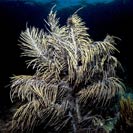
|

|
Sea plume |

|
Seefeder-bush |

|
Zeepluim |

|
Plume de mer |

|
Pluma de mar |

|
|
|
The tropical Atlantic
The tropical Pacific
The Red Sea
The Indian Ocean |
|
Substrate and environment |
|
The species is generally attached to a reef
The species can be found between 1 and 55 Meters
Common species.
|
|
General characteristics of the species |
|
Maximum size of the colony : 200 cm
The animal can show variable colouring
Lives in partnership with algae
|
|
Relationship with humans |
The species is not irritant
The species is exploited in the following sector(s) :
- Aquarium enthusiasts.
|
|
The species can be confused with other species of similar appearance! |
|
Pterogorgia anceps |
Distribution |

|

|
Angular sea whip |

|
Winkelseepeitsche |

|
Hoekige zeeveter |

|
Lacet de mer anguleux |

|
Cordón de mar anguloso |

|
|
|
The tropical Atlantic |
|
Substrate and environment |
|
The species is generally found in a sandy/silty area
The species can be found between 4 and 22 Meters
Common species.
|
|
General characteristics of the species |
|
Maximum size of the colony : 50 cm
The animal can show variable colouring
|
|
Relationship with humans |
The species is not irritant
The species is exploited in the following sector(s) :
- Aquarium enthusiasts.
- Chemistry/pharmacy.
|
|
Pterogorgia guadalupensis |
Distribution |

|

|
Grooved-blade sea whip |

|
Blattartige See-Peitsche |

|
Gegroefde zeeveter |

|
Lacet de mer rainuré |

|
Cordón de mar ranurado |

|
|
|
The tropical Atlantic |
|
Substrate and environment |
|
The species is generally found in a sandy/silty area
The species can be found between 1 and 20 Meters
Uncommon Species
|
|
General characteristics of the species |
|
Maximum size of the colony : 60 cm
The animal can show variable colouring
Lives in partnership with algae
|
|
Relationship with humans |
The species is not irritant
The species is exploited in the following sector(s) :
- Aquarium enthusiasts.
|
|
The species can be confused with other species of similar appearance! |
|
Rumphella aggregata |
Distribution |

|

|
Branching sea plume |

|
Busch - Gorgonie |

|
|

|
Gorgone cornée |

|
Gorgonia escoba marrón |

|
Gorgonia marrone |
|
The tropical Pacific
The Red Sea
The Indian Ocean |
|
Substrate and environment |
|
The species is generally attached to a reef
The species can be found between 2 and 40 Meters
Uncommon Species
|
|
General characteristics of the species |
|
Maximum size of the colony : 50 cm
Lives in partnership with algae
|
|
Relationship with humans |
The species is not irritant
The species is exploited in the following sector(s) :
- Aquarium enthusiasts.
|
|
The species can be confused with other species of similar appearance! |
|
Sarcophyton sp |
Distribution |

|

|
Leather coral |

|
|

|
|

|
Alcyonaire champignon |

|
|

|
|
|
The tropical Pacific
The Red Sea
The Indian Ocean |
|
Substrate and environment |
|
The species is generally attached to a reef
The species can be found between 1 and 30 Meters
Very common species.
|
|
General characteristics of the species |
|
Maximum size of the colony : 80 cm
The animal can show variable colouring
Lives in partnership with algae
|
|
Relationship with humans |
The species is not irritant
The species is exploited in the following sector(s) :
- Aquarium enthusiasts.
|
|
The species can be confused with other species of similar appearance! |
|
Sinularia polydactyla |
Distribution |

|

|
Finger Leather Coral |

|
Pumpende Weichkoralle |

|
|

|
Corail cuir digité |

|
|

|
|
|
The tropical Pacific
The Red Sea
The Indian Ocean |
|
Substrate and environment |
|
The species is generally attached to a reef
The species can be found between 1 and 30 Meters
Very common species.
|
|
General characteristics of the species |
|
Maximum size of the colony : 50 cm
The animal can show variable colouring The form of the animal can vary greatly
Lives in partnership with algae
|
|
Relationship with humans |
The species is not irritant
The species is exploited in the following sector(s) :
- Aquarium enthusiasts.
|
|
The species can be confused with other species of similar appearance! |
|
Swiftia exserta |
Distribution |

|

|
Red polyp octocoral |

|
Rot Tiefsee-Gorgonie |

|
Rode diepwatergorgoon |

|
Gorgone rouge des profondeurs |

|
Gorgonia roja de las profundidades |

|
|
|
The tropical Atlantic |
|
Substrate and environment |
|
The species is generally attached to a reef
Often in a cavity or under an overhang
The species can be found between 15 and 90 Meters
Uncommon Species
|
|
General characteristics of the species |
|
Maximum size of the colony : 45 cm
|
|
Relationship with humans |
The species is not irritant
The species is exploited in the following sector(s) :
- Aquarium enthusiasts.
|
|
Thesea nivea |
Distribution |

|

|
White eye sea spray |

|
Weißer Auge Seespray |

|
Witte oog schoof zee |

|
Gerbe de mer à points blancs |

|
Gavilla de mar en puntos blancos |

|
|
|
The tropical Atlantic |
|
Substrate and environment |
|
The species is generally attached to a reef
The species can be found between 25 and 400 Meters
Common species.
|
|
General characteristics of the species |
|
Maximum size of the colony : 45 cm
|
|
Relationship with humans |
|
The species is not irritant
|
|
virgularia mirabilis |
Distribution |

|

|
Sea pens |

|
Seefeder |

|
Slanke zeeveer |

|
Plume élégante |

|
Pluma de mar |

|
Penne di mare |
|
The temperate Atlantic
The Mediterranean |
|
Substrate and environment |
|
The species is generally found in a sandy/silty area
The species can be found between 10 and 400 Meters
Rare species.
|
|
General characteristics of the species |
|
Maximum size of the colony : 60 cm
|
|
Relationship with humans |
|
The species is not irritant
|
|
Xenia umbellata |
Distribution |

|

|
Umbrella xenia |

|
Pumpende Straussenkoralle |

|
|

|
Corail à polypes battants |

|
|

|
|
|
The tropical Pacific
The Red Sea
The Indian Ocean |
|
Substrate and environment |
|
The species is generally attached to a reef
The species can be found between 3 and 15 Meters
Common species.
|
|
General characteristics of the species |
|
Maximum size of the colony : 20 cm
Lives in partnership with one or more fishes Lives in partnership with algae
|
|
Relationship with humans |
The species is not irritant
The species is exploited in the following sector(s) :
- Aquarium enthusiasts.
|
|
The species can be confused with other species of similar appearance! |
|
Aglaophenia sp |
Distribution |

|

|
Sea-fern |

|
Federpolyp |

|
Veerhydroïd |

|
Plumulaire |

|
Plumularia |

|
Plumularia |
|
The tropical Atlantic
The temperate Atlantic
The tropical Pacific
The Red Sea
The Indian Ocean
The Mediterranean |
|
Substrate and environment |
|
The species is generally attached to a reef
Often in a cavity or under an overhang
The species can be found between 0 and 20 Meters
Common species.
|
|
General characteristics of the species |
|
Maximum size of the colony : 15 cm
|
|
Relationship with humans |
|
The species is not irritant
|
|
Aglaophenia tubulifera |
Distribution |

|

|
Sea-fern |

|
Federpolyp |

|
Veerhydroïd |

|
Plumulaire |

|
Plumularia |

|
|
|
The temperate Atlantic |
|
Substrate and environment |
|
The species is generally attached to a reef
The species can be found between 10 and 80 Meters
Common species.
|
|
General characteristics of the species |
|
Maximum size of the colony : 7 cm
|
|
Relationship with humans |
|
The species is not irritant
|
|
The species can be confused with other species of similar appearance! |
|
Antenella sp |
Distribution |

|

|
Antenella |

|
Antenella |

|
Antenella |

|
Antenelle |

|
Antenella |

|
Antenella |
|
The tropical Atlantic
The temperate Atlantic
The Mediterranean |
|
Substrate and environment |
|
The species is generally attached to a reef
Generally in an area where there is a current
The species can be found between 5 and 1200 Meters
Uncommon Species
|
|
General characteristics of the species |
|
Maximum size of the colony : 3 cm
|
|
Relationship with humans |
|
The species is not irritant
|
|
Cnidoscyphus marginatus |
Distribution |

|

|
Unbranched hydroid |

|
Unverzweigte Hydroide |

|
Onvertakte hydroïde |

|
Hydraire non ramifié |

|
Hidroidea no ramificada |

|
|
|
The tropical Atlantic |
|
Substrate and environment |
|
The species is generally attached to a reef
Often in a cavity or under an overhang
The species can be found between 2 and 45 Meters
Common species.
|
|
General characteristics of the species |
|
Maximum size of the colony : 10 cm
|
|
Relationship with humans |
|
The species is slightly irritant
|
|
Eudendrium rameum |
Distribution |

|

|
Tree-hydroid |

|
Bäumchenpolyp |

|
Boompjeshydroïd |

|
Hydraire dendriforme |

|
Eudendrium |

|
Eudendrio |
|
The Mediterranean |
|
Substrate and environment |
|
The species is generally attached to a reef
Often in a cavity or under an overhang
The species can be found between 5 and 30 Meters
Common species.
|
|
General characteristics of the species |
|
Maximum size of the colony : 20 cm
|
|
Relationship with humans |
|
The species is not irritant
|
|
The species can be confused with other species of similar appearance! |
|
Gymnangium speciosum |
Distribution |
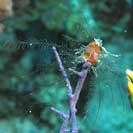
|

|
Feather hydroid |

|
Federförmige Hydrozoe |

|
Veer-hydroïde |

|
Hydraire-plume |

|
Hidroidea pluma |

|
|
|
The tropical Atlantic |
|
Substrate and environment |
|
The species is generally attached to a reef
Generally in an area where there is a current
The species can be found between 5 and 35 Meters
Common species.
|
|
General characteristics of the species |
|
Maximum size of the colony : 20 cm
|
|
Relationship with humans |
|
The species is slightly irritant
|
|
The species can be confused with other species of similar appearance! |
|
Gymnangium montagui |
Distribution |

|

|
Golden sea-fern |

|
Goldfederpolyp |

|
Gouden veerhydroïd |

|
Plume d'or |

|
Plumularia de oro |

|
|
|
The temperate Atlantic |
|
Substrate and environment |
|
The species is generally attached to a reef
The species can be found between 10 and 40 Meters
Uncommon Species
|
|
General characteristics of the species |
|
Maximum size of the colony : 15 cm
|
|
Relationship with humans |
|
The species is not irritant
|
|
Halecium halecium |
Distribution |

|

|
Herring-bone hydroid |

|
Fiederzweigpolyp |

|
Haringgraat |

|
Hydraire petit sapin |

|
Abeto de mar pequeño |

|
|
|
The temperate Atlantic
The Mediterranean |
|
Substrate and environment |
|
The species is generally attached to a reef
The species can be found between 10 and 1300 Meters
Common species.
|
|
General characteristics of the species |
|
Maximum size of the colony : 25 cm
|
|
Relationship with humans |
|
The species is not irritant
|
|
The species can be confused with other species of similar appearance! |
|
Halocordyle disticha |
Distribution |

|

|
Sea-nettle |

|
Seebrennessel |

|
Zeebrandnetel |

|
Ortie de mer |

|
Ortiga de mar |

|
Ortica di mare |
|
The tropical Atlantic
The temperate Atlantic
The Mediterranean |
|
Substrate and environment |
|
The species is generally attached to a reef
Generally in an area where there is a current
The species can be found between 10 and 30 Meters
Uncommon Species
|
|
General characteristics of the species |
|
Maximum size of the colony : 20 cm
|
|
Relationship with humans |
|
The species is irritant
|
|
Macrorhyncha robusta |
Distribution |

|

|
Stinging bush hydroid |

|
Buschige hydrozoe |

|
Stekende struik-hydroïde |

|
Hydraire-buisson urticant |

|
Hidroidea arbusto urticante |

|
|
|
The tropical Atlantic |
|
Substrate and environment |
|
The species is generally attached to a reef
Generally in an area where there is a current
The species can be found between 6 and 35 Meters
Uncommon Species
|
|
General characteristics of the species |
|
Maximum size of the colony : 24 cm
|
|
Relationship with humans |
|
The species is very irritant
|
|
Millepora alcicornis |
Distribution |
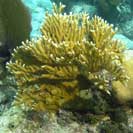
|

|
Branching fire-coral |

|
Verzweigte Feuerkoralle |

|
Vertakt brandkoraal |

|
Corail de feu ramifié |

|
Coral de fuego ramificado |

|
Corallo di fuoco |
|
The tropical Atlantic |
|
Substrate and environment |
|
The species is generally attached to a reef
The species can be found between 0 and 45 Meters
Common species.
|
|
General characteristics of the species |
|
Maximum size of the colony : 50 cm
|
|
Relationship with humans |
The species is irritant
The species is exploited in the following sector(s) :
- Aquarium enthusiasts.
|
|
Millepora complanata |
Distribution |
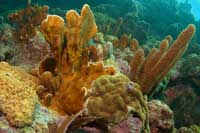
|

|
Plate fire-coral |

|
Blattförmige Feuerkoralle |

|
Plaat-brandkoraal |

|
Corail de feu en plaques |

|
Hoja de fuego |

|
Corallo di fuoco |
|
The tropical Atlantic |
|
Substrate and environment |
|
The species is generally attached to a reef
Generally in an area where there is a current
The species can be found between 0 and 15 Meters
Common species.
|
|
General characteristics of the species |
|
Maximum size of the colony : 50 cm
|
|
Relationship with humans |
The species is irritant
The species is exploited in the following sector(s) :
- Aquarium enthusiasts.
|
|
Millepora dichotoma |
Distribution |

|

|
Ramified fire-coral |

|
Gitter-Feuerkoralle |

|
|

|
Corail de feu ramifié |

|
Coral de fuego ramificado |

|
Corallo di fuoco |
|
The tropical Pacific
The Red Sea
The Indian Ocean |
|
Substrate and environment |
|
The species is generally attached to a reef
The species can be found between 1 and 25 Meters
Very common species.
|
|
General characteristics of the species |
|
Maximum size of the colony : 100 cm Diameter of the polyp : 1 mm
|
|
Relationship with humans |
|
The species is very irritant
|
|
Millepora platyphylla |
Distribution |

|

|
Plate fire-coral |

|
Platten-Feuerkoralle |

|
|

|
Corail de feu en plaques |

|
Coral de fuego plato |

|
Corallo di fuoco |
|
The tropical Pacific
The Red Sea
The Indian Ocean |
|
Substrate and environment |
|
The species is generally attached to a reef
Generally in an area where there is a current
The species can be found between 0 and 25 Meters
Very common species.
|
|
General characteristics of the species |
|
Maximum size of the colony : 70 cm Diameter of the polyp : 1 mm
|
|
Relationship with humans |
|
The species is very irritant
|
|
Millepora braziliensis |
Distribution |

|
|
|
|
Substrate and environment |
|
The species is generally attached to a reef
The species can be found between 0 and 30 Meters
Very common species.
Endemic species.
|
|
General characteristics of the species |
|
Maximum size of the colony : 40 cm
|
|
Relationship with humans |
The species is irritant
The species is exploited in the following sector(s) :
- Aquarium enthusiasts.
Used in the clothing, footwear or crafts industries for the manufacture of articles (jewellery, etc.).
|
|
Nemertesia antennina |
Distribution |

|

|
Sea beard |

|
Antennepolyp |

|
Zeespriet |

|
Hydraire-antenne |

|
Hidroideoantena |

|
|
|
The temperate Atlantic
The Mediterranean |
|
Substrate and environment |
|
The species is generally attached to a reef
The species can be found between 10 and 100 Meters
Common species.
|
|
General characteristics of the species |
|
Maximum size of the colony : 30 cm
|
|
Relationship with humans |
|
The species is not irritant
|
|
The species can be confused with other species of similar appearance! |
|
Ralpharia gorgoniae |
Distribution |

|

|
Solitary gorgonian hydroid |

|
Fächerkorallen-Hydrozoe |

|
Gorgoon-hydroïde |

|
Hydraire des gorgones |

|
Hidroidea de gorgonias |

|
|
|
The tropical Atlantic |
|
Substrate and environment |
|
Generally, the species is attached to another cnidarian
Generally in an area where there is a current
The species can be found between 4 and 25 Meters
Uncommon Species
|
|
General characteristics of the species |
|
Maximum size of the colony : 3 cm
|
|
Relationship with humans |
|
The species is irritant
|
|
Sertularella speciosa |
Distribution |

|

|
Branching hydroid |

|
Verzweigte Hydrozoe |

|
Vertakte hydroïde |

|
Hydraire ramifié |

|
Hidroidea ramificada |

|
|
|
The tropical Atlantic |
|
Substrate and environment |
|
The species is generally attached to a reef
Generally in an area where there is a current
The species can be found between 10 and 35 Meters
Common species.
|
|
General characteristics of the species |
|
Maximum size of the colony : 15 cm
|
|
Relationship with humans |
|
The species is slightly irritant
|
|
The species can be confused with other species of similar appearance! |
|
Sertularella sp |
Distribution |

|

|
Sea-oak |

|
Zwergmoos |

|
Zee-eik |

|
Sertularelle |

|
Sertularella |

|
Sertularella |
|
The temperate Atlantic
The Mediterranean |
|
Substrate and environment |
|
The species is generally attached to a reef
Generally in an area where there is a current
The species can be found between 0 and 20 Meters
Common species.
|
|
General characteristics of the species |
|
Maximum size of the colony : 6 cm
|
|
Relationship with humans |
|
The species is not irritant
|
|
Sertularella polyzonias |
Distribution |

|

|
Great tooth hydroid |

|
Zwergmoos |

|
Zee-eik |

|
Sertularella |

|
Sertularella |

|
Sertularella |
|
The temperate Atlantic
The Mediterranean |
|
Substrate and environment |
|
The species is generally attached to a reef
Generally in an area where there is a current
The species can be found between 5 and 20 Meters
Uncommon Species
|
|
General characteristics of the species |
|
Maximum size of the colony : 7 cm
|
|
Relationship with humans |
|
The species is not irritant
|
|
The species can be confused with other species of similar appearance! |
|
Stylaster roseus |
Distribution |
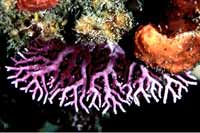
|

|
Rose lace-coral |

|
Rosa Spitzen-Koralle |

|
Roze kantkoraal |

|
Corail dentelle |

|
Coral rosa |

|
|
|
The tropical Atlantic |
|
Substrate and environment |
|
The species is generally attached to a reef
Often in a cavity or under an overhang
The species can be found between 0 and 40 Meters
Common species.
|
|
General characteristics of the species |
|
Maximum size of the colony : 10 cm
The animal can show variable colouring
|
|
Relationship with humans |
|
The species is slightly irritant
|
|
Tamarisca tamarisca |
Distribution |

|

|
Sea tamarind |

|
See-Tamarinde |

|
Zeetamarinde |

|
Tamaris de mer |

|
Tamaris de mar |

|
|
|
The temperate Atlantic |
|
Substrate and environment |
|
The species is generally attached to a reef
The species can be found between 10 and 250 Meters
Uncommon Species
|
|
General characteristics of the species |
|
Maximum size of the colony : 60 cm
|
|
Relationship with humans |
|
The species is not irritant
|
|
Thyroscyphus ramosus |
Distribution |

|

|
Algae hydroid |

|
Algenartige Hydrozoe |

|
Alg-hydroïde |

|
Hydraire-algue |

|
Hidroidea-alga |

|
|
|
The tropical Atlantic |
|
Substrate and environment |
|
The species is generally attached to a reef
The species can be found between 2 and 45 Meters
Common species.
|
|
General characteristics of the species |
|
Maximum size of the colony : 15 cm
|
|
Relationship with humans |
|
The species is slightly irritant
|
|
The species can be confused with other species of similar appearance! |
|
Actinia equina |
Distribution |
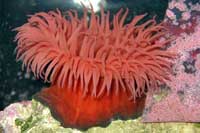
|

|
Beadlet anemone |

|
Pferdeaktinie |

|
Paardeanemoon |

|
Tomate de mer |

|
Tomate de mar |

|
Pomodoro di mare |
|
The temperate Atlantic
The Mediterranean |
|
Substrate and environment |
|
The species is generally attached to a reef
The species can be found between 0 and 8 Meters
Very common species.
|
|
General characteristics of the species |
|
Diameter of the polyp : 60 mm
The animal can show variable colouring
|
|
Relationship with humans |
|
The species is slightly irritant
|
|
Actinia fragacea |
Distribution |
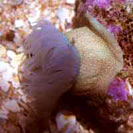
|

|
Strawberry anemone |

|
|

|
Aardbeianemoon |

|
Anémone fraise |

|
|

|
Fragola di mare |
|
The temperate Atlantic
The Mediterranean |
|
Substrate and environment |
|
The species is generally attached to a reef
Often in a cavity or under an overhang
The species can be found between 0 and 10 Meters
Uncommon Species
|
|
General characteristics of the species |
|
Diameter of the polyp : 100 mm
|
|
Relationship with humans |
The species is slightly irritant
The species is exploited in the following sector(s) :
- Aquarium enthusiasts.
|
|
The species can be confused with other species of similar appearance! |
|
Actinodendron arboreum |
Distribution |

|
|
The tropical Pacific
The Red Sea
The Indian Ocean |
|
Substrate and environment |
|
The species is generally found in a sandy/silty area
The species can be found between 1 and 30 Meters
Rare species.
|
|
General characteristics of the species |
|
Diameter of the polyp : 500 mm
Lives in partnership with algae
|
|
Relationship with humans |
|
The species is irritant
|
|
The species can be confused with other species of similar appearance! |
|
Actinothoe sphyrodeta |
Distribution |

|

|
Daisy anemone |

|
Schlangenharrose |

|
Weduweroosje |

|
Anémone marguerite |

|
Attinia bianca |

|
|
|
The temperate Atlantic |
|
Substrate and environment |
|
The species is generally attached to a reef
The species can be found between 2 and 40 Meters
Common species.
|
|
General characteristics of the species |
|
Diameter of the polyp : 30 mm
The animal can show variable colouring
|
|
Relationship with humans |
|
The species is not irritant
|
|
Adamsia palliata |
Distribution |

|

|
Cloak anemone |

|
Mantelacktinie |

|
Mantelanemoon |

|
Anémone manteau |

|
Anémona comensal |

|
|
|
The temperate Atlantic
The Mediterranean |
|
Substrate and environment |
|
The species is generally found in a sandy/silty area
The species can be found between 0 and 200 Meters
Uncommon Species
|
|
General characteristics of the species |
|
Diameter of the polyp : 100 mm
Lives in partnership with one or more crustaceans
|
|
Relationship with humans |
|
The species is slightly irritant
|
|
Aiptasia tagetes |
Distribution |

|

|
Pale anemone |

|
Blasse Anemone |

|
Glasanemoon |

|
Anémone pâle |

|
Anémona pálida |

|
|
|
The tropical Atlantic |
|
Substrate and environment |
|
The species is generally attached to a reef
The species can be found between 0 and 33 Meters
Common species.
|
|
General characteristics of the species |
|
Diameter of the polyp : 55 mm
The animal can show variable colouring
|
|
Relationship with humans |
|
The species is not irritant
|
|
Aiptasia mutabilis |
Distribution |
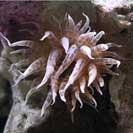
|

|
Trumpet anemone |

|
Grüne Aiptasie |

|
Groene glasanemoon |

|
Aiptasie verte |

|
Aiptasia verde |

|
Anemone bruno |
|
The temperate Atlantic
The Mediterranean |
|
Substrate and environment |
|
The species is generally attached to a reef
The species can be found between 0 and 100 Meters
Uncommon Species
Endemic species.
|
|
General characteristics of the species |
|
Maximum size of the colony : 0 cm Diameter of the polyp : 100 mm
Lives in partnership with algae
|
|
Relationship with humans |
|
The species is slightly irritant
|
|
Aiptasia diaphana |
Distribution |
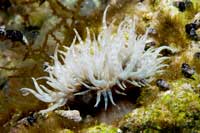
|

|
Yellow Aiptasia |

|
Gelbe Aiptasie |

|
Gele glasanemoon |

|
Aiptasie jaune |

|
Aiptasia amarilla |

|
Aiptasia gialla |
|
The Mediterranean |
|
Substrate and environment |
|
The species is generally attached to a reef
The species can be found between 0 and 2 Meters
Common species.
|
|
General characteristics of the species |
|
Diameter of the polyp : 50 mm
Lives in partnership with algae
|
|
Relationship with humans |
|
The species is slightly irritant
|
|
Alicia mirabilis |
Distribution |

|

|
Berried anemone |

|
Wunder Anemone |

|
Alicia |

|
Alicia |

|
Alicia |

|
|
|
The tropical Atlantic
The temperate Atlantic
The Mediterranean |
|
Substrate and environment |
|
The species is generally found in a sandy/silty area
The species can be found between 1 and 40 Meters
Rare species.
|
|
General characteristics of the species |
|
Maximum size of the colony : 0 cm Diameter of the polyp : 400 mm
|
|
Relationship with humans |
|
The species is slightly irritant
|
|
Anemonia viridis |
Distribution |
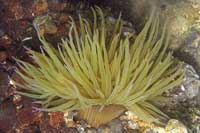
|

|
Snake-locks anemone |

|
Wachsrose |

|
Wasroos |

|
Anémone verte |

|
Actinia comun |

|
Anemone capelli di serpe |
|
The temperate Atlantic
The Mediterranean |
|
Substrate and environment |
|
The species is generally attached to a reef
The species can be found between 0 and 20 Meters
Very common species.
|
|
General characteristics of the species |
|
Diameter of the polyp : 200 mm
Lives in partnership with one or more fishes Lives in partnership with one or more crustaceans Lives in partnership with algae
|
|
Relationship with humans |
The species is slightly irritant
The species is exploited in the following sector(s) :
- Chemistry/pharmacy.
|
|
Anemonia melanaster |
Distribution |

|

|
Sargassum anemone |

|
Sargasso Anemone |

|
|

|
Anémone des sargasses |

|
|

|
|
|
The tropical Atlantic
The temperate Atlantic |
|
Substrate and environment |
|
The species is generally attached to a reef
The species can be found between 1 and 26 Meters
Common species.
|
|
General characteristics of the species |
|
Diameter of the polyp : 50 mm
|
|
Relationship with humans |
|
The species is not irritant
|
|
Bartholomea annulata |
Distribution |

|

|
Corkscrew anemone |

|
Korkenzieher-Anemone |

|
Kurkentrekker-anemoon |

|
Anémone tire-bouchon |

|
Anémona sacacorchos |

|
Attinia ad anelli |
|
The tropical Atlantic |
|
Substrate and environment |
|
The species is generally attached to a reef
Often in a cavity or under an overhang
The species can be found between 2 and 45 Meters
Common species.
|
|
General characteristics of the species |
|
Maximum size of the colony : 0 cm Diameter of the polyp : 200 mm
Lives in partnership with one or more crustaceans
|
|
Relationship with humans |
The species is slightly irritant
The species is exploited in the following sector(s) :
- Aquarium enthusiasts.
|
|
Bunodosoma granulifera |
Distribution |
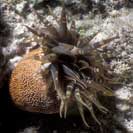
|

|
Red warty anemone |

|
Rote Warzeanemone |

|
Wratachtige rode anemoon |

|
Anémone rouge verruqueuse |

|
Anémona roja verrugosa |

|
|
|
The tropical Atlantic |
|
Substrate and environment |
|
The species is generally attached to a reef
The species can be found between 0 and 10 Meters
Uncommon Species
|
|
General characteristics of the species |
|
Maximum size of the colony : 0 cm Diameter of the polyp : 100 mm
|
|
Relationship with humans |
The species is not irritant
The species is exploited in the following sector(s) :
- Chemistry/pharmacy.
|
|
Calliactis tricolor |
Distribution |
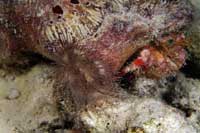
|

|
Hitchhicking anemone |

|
Trampenanemone |

|
Liftanemoon |

|
Anémone des symbiotes |

|
Anémona de Ermitaño |

|
|
|
The tropical Atlantic |
|
Substrate and environment |
|
The species is generally attached to a reef
The species can be found between 0 and 30 Meters
Uncommon Species
|
|
General characteristics of the species |
|
Maximum size of the colony : 10 cm Diameter of the polyp : 60 mm
The animal can show variable colouring
Lives in partnership with one or more crustaceans
|
|
Relationship with humans |
|
The species is not irritant
|
|
The species can be confused with other species of similar appearance! |
|
Calliactis parasitica |
Distribution |
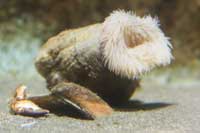
|

|
Hermit anemone |

|
Einsiedler-seerose |

|
Heremietanemoon |

|
Anémone parasite |

|
Anémona del ermitaño |

|
Attinia del paguro |
|
The temperate Atlantic
The Mediterranean |
|
Substrate and environment |
|
The species is generally found in a sandy/silty area
The species can be found between 3 and 130 Meters
Uncommon Species
|
|
General characteristics of the species |
|
Maximum size of the colony : 0 cm Diameter of the polyp : 40 mm
Lives in partnership with one or more crustaceans
|
|
Relationship with humans |
|
The species is slightly irritant
|
|
The species can be confused with other species of similar appearance! |
|
Cereus pedunculatus |
Distribution |

|

|
Daisy anemone |

|
Sonnenrose |

|
Zonneroosje |

|
Anémone solaire |

|
Actinia solar |

|
Anemonia solare |
|
The temperate Atlantic
The Mediterranean |
|
Substrate and environment |
|
The species is generally attached to a reef
The species can be found between 5 and 80 Meters
Uncommon Species
|
|
General characteristics of the species |
|
Diameter of the polyp : 12 mm
The animal can show variable colouring
Lives in partnership with algae
|
|
Relationship with humans |
|
The species is not irritant
|
|
Ceriantheomorphe brasiliensis |
Distribution |

|

|
Giant tube-dwelling anemone |

|
Riesig Zylinderrose |

|
Reusachtig buisanemoon |

|
Cérianthe géante |

|
Ceriantario gigante |

|
|
|
The tropical Atlantic |
|
Substrate and environment |
|
The species is generally found in a sandy/silty area
The species can be found between 5 and 20 Meters
Rare species.
|
|
General characteristics of the species |
|
Maximum size of the colony : 0 cm Diameter of the polyp : 300 mm
|
|
Relationship with humans |
|
The species is not irritant
|
|
Cerianthus sp |
Distribution |
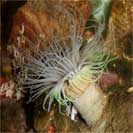
|

|
Tube anemone |

|
Zylinderrose |

|
Kokeranemoon |

|
Cérianthe |

|
Anémona tubulada |

|
|
|
The tropical Pacific
The Mediterranean |
|
Substrate and environment |
|
The species is generally found in a sandy/silty area
|
|
General characteristics of the species |
|
Diameter of the polyp : 100 mm
Lives in partnership with one or more crustaceans
|
|
Relationship with humans |
The species is not irritant
The species is exploited in the following sector(s) :
- Aquarium enthusiasts.
|
|
Cerianthus membranaceus |
Distribution |
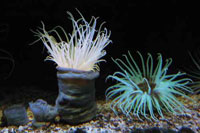
|

|
Tube anemone |

|
Grosse Zylinderrose |

|
Kokeranemone |

|
Grand cérianthe |

|
Cerianto grande |

|
Cerianto |
|
The temperate Atlantic
The Mediterranean |
|
Substrate and environment |
|
The species is generally found in a sandy/silty area
Often in a cavity or under an overhang
The species can be found between 1 and 40 Meters
Common species.
|
|
General characteristics of the species |
|
Diameter of the polyp : 400 mm
The animal can show variable colouring
Lives in partnership with one or more crustaceans
|
|
Relationship with humans |
The species is not irritant
The species is exploited in the following sector(s) :
- Aquarium enthusiasts.
|
|
Condylactis gigantea |
Distribution |
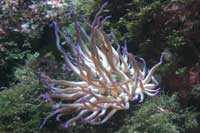
|

|
Giant anemone |

|
Riesen-Anemone |

|
Caribische reuzenanemoon |

|
Anémone géante |

|
Anémona gigante |

|
Attinia gigante della sabbia |
|
The tropical Atlantic |
|
Substrate and environment |
|
The species is generally attached to a reef
The species can be found between 5 and 35 Meters
Common species.
|
|
General characteristics of the species |
|
Diameter of the polyp : 320 mm
The animal can show variable colouring
Lives in partnership with one or more fishes Lives in partnership with one or more crustaceans
|
|
Relationship with humans |
The species is slightly irritant
The species is exploited in the following sector(s) :
- Aquarium enthusiasts.
|
|
Condylactis aurantiaca |
Distribution |
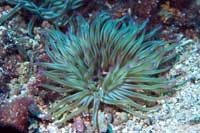
|

|
Golden anemone |

|
Goldfarbige Seerose |

|
Gouden zeeroos |

|
Anémone soleil |

|
Anemona dorada |

|
Attinia di rena |
|
The Mediterranean |
|
Substrate and environment |
|
The species is generally found in a sandy/silty area
The species can be found between 5 and 80 Meters
Rare species.
Endemic species.
|
|
General characteristics of the species |
|
Diameter of the polyp : 250 mm
The animal can show variable colouring
Lives in partnership with one or more crustaceans Lives in partnership with algae
|
|
Relationship with humans |
|
The species is not irritant
|
|
The species can be confused with other species of similar appearance! |
|
Corynactis viridis |
Distribution |

|

|
Jewel-anemone |

|
Juwelenanemone |

|
Juweelanemoon |

|
Anémone-bijou |

|
Actinia piedra preciosa |

|
Attinia gioiello |
|
The temperate Atlantic
The Mediterranean |
|
Substrate and environment |
|
The species is generally attached to a reef
Often in a cavity or under an overhang
The species can be found between 1 and 100 Meters
Common species.
|
|
General characteristics of the species |
|
Diameter of the polyp : 15 mm
The animal can show variable colouring
|
|
Relationship with humans |
The species is not irritant
The species is exploited in the following sector(s) :
- Aquarium enthusiasts.
|
|
Corynactis caribbeorum |
Distribution |

|

|
Orange ball corallimorph |

|
Karibische Juwelenanemone |

|
|

|
Corallimorphaire jongleur |

|
Coralimorfo de bolas |

|
|
|
The tropical Atlantic
The temperate Atlantic |
|
Substrate and environment |
|
The species is generally attached to a reef
The species can be found between 1 and 100 Meters
Rare species.
|
|
General characteristics of the species |
|
Diameter of the polyp : 60 mm
The animal can show variable colouring
|
|
Relationship with humans |
|
The species is not irritant
|
|
Cribrinopsis crassa |
Distribution |

|

|
Fat anemone |

|
Fleischanemone |

|
Dikke anemoon |

|
Anémone charnue |

|
Actinia gorda |

|
Attinia grossa |
|
The Mediterranean |
|
Substrate and environment |
|
The species is generally attached to a reef
The species can be found between 0 and 80 Meters
Common species.
Endemic species.
|
|
General characteristics of the species |
|
Diameter of the polyp : 100 mm
Lives in partnership with one or more crustaceans Lives in partnership with algae
|
|
Relationship with humans |
|
The species is irritant
|
|
Cryptodendrum adhaesivum |
Distribution |

|

|
Pizza sea anemone |

|
Noppenrandanemone |

|
|

|
Anémone collante |

|
|

|
|
|
The tropical Pacific
The Red Sea
The Indian Ocean |
|
Substrate and environment |
|
The species is generally attached to a reef
The species can be found between 0 and 10 Meters
Uncommon Species
|
|
General characteristics of the species |
|
Diameter of the polyp : 350 mm
The animal can show variable colouring
Lives in partnership with one or more fishes Lives in partnership with one or more crustaceans Lives in partnership with algae
|
|
Relationship with humans |
The species is not irritant
The species is exploited in the following sector(s) :
- Aquarium enthusiasts.
|
|
Discosoma nummiforme |
Distribution |

|

|
Mushroom anemone |

|
Rote Scheibenanemone |

|
Rode schijfanemoon |

|
Anémone champignon |

|
|

|
|
|
The tropical Pacific
The Red Sea
The Indian Ocean |
|
Substrate and environment |
|
The species is generally attached to a reef
The species can be found between 1 and 30 Meters
Very common species.
|
|
General characteristics of the species |
|
Diameter of the polyp : 10 mm
The animal can show variable colouring
Lives in partnership with algae
|
|
Relationship with humans |
The species is not irritant
The species is exploited in the following sector(s) :
- Aquarium enthusiasts.
|
|
The species can be confused with other species of similar appearance! |
|
Entacmaea quadricolor |
Distribution |

|

|
Bulb-tentacle sea anemone |

|
Blasenanemone |

|
Blaas anemoon |

|
Anémone à bouts renflés |

|
Anémona burbuja |

|
Attinia a fiasco |
|
The tropical Pacific
The Red Sea
The Indian Ocean |
|
Substrate and environment |
|
The species is generally attached to a reef
The species can be found between 1 and 30 Meters
Common species.
|
|
General characteristics of the species |
|
Maximum size of the colony : 40 cm Diameter of the polyp : 400 mm
The animal can show variable colouring
Lives in partnership with one or more fishes Lives in partnership with one or more crustaceans
|
|
Relationship with humans |
|
The species is not irritant
|
|
Epicystis crucifer |
Distribution |

|

|
Beaded anemone |

|
Rosenkranz-Anemone |

|
Kralenanemoon |

|
Anémone perlée |

|
Anémona-rosario |

|
|
|
The tropical Atlantic |
|
Substrate and environment |
|
The species is generally found in a sandy/silty area
The species can be found between 2 and 10 Meters
Uncommon Species
|
|
General characteristics of the species |
|
Diameter of the polyp : 150 mm
|
|
Relationship with humans |
The species is slightly irritant
The species is exploited in the following sector(s) :
- Aquarium enthusiasts.
|
|
Epizoanthus couchii |
Distribution |

|

|
Brown encrusting anemone |

|
Braune Krustenanemone |

|
Bruine korstanemoon |

|
Anémone encroûtante brune |

|
Actinia encostrante marron |

|
|
|
The temperate Atlantic |
|
Substrate and environment |
|
The species is generally attached to a reef
Often in a cavity or under an overhang
The species can be found between 0 and 100 Meters
Uncommon Species
|
|
General characteristics of the species |
|
Diameter of the polyp : 5 mm
|
|
Relationship with humans |
|
The species is not irritant
|
|
The species can be confused with other species of similar appearance! |
|
Heteractis magnifica |
Distribution |

|

|
Magnificent sea anemone |

|
Prachtanemone |

|
Witte symbiose anemoon |

|
Anémone magnifique |

|
Anémona magnifica |

|
Attinia dal piede rosso |
|
The tropical Pacific
The Red Sea
The Indian Ocean |
|
Substrate and environment |
|
The species is generally attached to a reef
The species can be found between 1 and 30 Meters
Uncommon Species
|
|
General characteristics of the species |
|
Maximum size of the colony : 100 cm Diameter of the polyp : 1000 mm
Lives in partnership with one or more fishes Lives in partnership with one or more crustaceans Lives in partnership with algae
|
|
Relationship with humans |
The species is slightly irritant
The species is exploited in the following sector(s) :
- Aquarium enthusiasts.
|
|
Heteractis aurora |
Distribution |

|

|
Beaded sea anemone |

|
Glasperlenanemone |

|
Parelanemoon |

|
Anémone collier de perles |

|
Anémona perla de cristal |

|
Anemone a perline |
|
The tropical Pacific
The Red Sea
The Indian Ocean |
|
Substrate and environment |
|
The species is generally found in a sandy/silty area
The species can be found between 0 and 25 Meters
Uncommon Species
|
|
General characteristics of the species |
|
Maximum size of the colony : 40 cm Diameter of the polyp : 400 mm
Lives in partnership with one or more fishes Lives in partnership with one or more crustaceans
|
|
Relationship with humans |
The species is slightly irritant
The species is exploited in the following sector(s) :
- Aquarium enthusiasts.
|
|
Lebrunia coralligens |
Distribution |
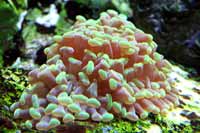
|

|
Hidden anemone |

|
Versteckte Anemone |

|
Verborgen anemone |

|
Anémone secrète |

|
Anémona secreta |

|
|
|
The tropical Atlantic |
|
Substrate and environment |
|
Generally, the species is attached to another cnidarian
Often in a cavity or under an overhang
The species can be found between 1 and 12 Meters
Uncommon Species
|
|
General characteristics of the species |
|
Maximum size of the colony : 0 cm Diameter of the polyp : 80 mm
|
|
Relationship with humans |
|
The species is slightly irritant
|
|
Metridium senile |
Distribution |

|

|
Plumose anemone |

|
Seenelke |

|
Zeeanjelier |

|
Œillet de mer |

|
Actinia plumosa |

|
|
|
The temperate Atlantic |
|
Substrate and environment |
|
The species is generally attached to a reef
The species can be found between 1 and 100 Meters
Uncommon Species
|
|
General characteristics of the species |
|
Diameter of the polyp : 150 mm
The animal can show variable colouring
|
|
Relationship with humans |
|
The species is not irritant
|
|
Palythoa sp |
Distribution |

|

|
Sea mats |

|
Krustenanemone |

|
Korstanemoon |

|
Zoanthaire encroûtant |

|
Zoantario incrustante |

|
|
|
The tropical Atlantic
The tropical Pacific
The Red Sea
The Indian Ocean |
|
Substrate and environment |
|
The species is generally attached to a reef
Generally in an area where there is a current
The species can be found between 0 and 20 Meters
Uncommon Species
|
|
General characteristics of the species |
|
Maximum size of the colony : 3 cm Diameter of the polyp : 7 mm
The animal can show variable colouring
|
|
Relationship with humans |
The species is not irritant
The species is exploited in the following sector(s) :
- Aquarium enthusiasts.
|
|
Parazoanthus axinellae |
Distribution |

|

|
Yellow encrusting anemone |

|
Gelbe Krusteanemone |

|
Gele korstanemoon |

|
Anémone encroûtante jaune |

|
Actinia encrostante amarilla |

|
Margherita di mare |
|
The temperate Atlantic
The Mediterranean |
|
Substrate and environment |
|
The species is generally attached to a reef
Often in a cavity or under an overhang
The species can be found between 1 and 200 Meters
Very common species.
|
|
General characteristics of the species |
|
Maximum size of the colony : 0 cm Diameter of the polyp : 10 mm
|
|
Relationship with humans |
The species is not irritant
The species is exploited in the following sector(s) :
- Aquarium enthusiasts.
|
|
The species can be confused with other species of similar appearance! |
|
Parazoanthus gracilis |
Distribution |

|

|
Yellow commensal anemon |

|
|

|
|

|
Anémone coloniale jaune |

|
|

|
|
|
The tropical Pacific
The Indian Ocean |
|
Substrate and environment |
|
The species is generally attached to a reef
Often in a cavity or under an overhang
The species can be found between 5 and 60 Meters
Very common species.
|
|
General characteristics of the species |
|
Maximum size of the colony : 30 cm Diameter of the polyp : 10 mm
|
|
Relationship with humans |
The species is not irritant
The species is exploited in the following sector(s) :
- Aquarium enthusiasts.
|
|
The species can be confused with other species of similar appearance! |
|
Phymanthus crucifer |
Distribution |

|

|
Rock flower anemone |

|
Rosenkranz-Anemone |

|
|

|
Anémone à chapelets |

|
Anemona rosario |

|
|
|
The tropical Atlantic
The temperate Atlantic |
|
Substrate and environment |
|
The species is generally found in a sandy/silty area
The species can be found between 3 and 20 Meters
Uncommon Species
|
|
General characteristics of the species |
|
Diameter of the polyp : 200 mm
The animal can show variable colouring
Lives in partnership with algae
|
|
Relationship with humans |
The species is not irritant
The species is exploited in the following sector(s) :
- Aquarium enthusiasts.
|
|
Ricordea florida |
Distribution |

|

|
Florida corallimorph |

|
Florida-Korallenanemone |

|
Florida-koraalanemoon |

|
Corallimorphaire de Floride |

|
Coralimorfo de Florida |

|
Ricordea |
|
The tropical Atlantic |
|
Substrate and environment |
|
The species is generally attached to a reef
The species can be found between 0 and 45 Meters
Uncommon Species
|
|
General characteristics of the species |
|
Diameter of the polyp : 80 mm
Lives in partnership with one or more crustaceans
|
|
Relationship with humans |
The species is not irritant
The species is exploited in the following sector(s) :
- Aquarium enthusiasts.
|
|
Sagartia elegans |
Distribution |

|

|
Sagartia anemone |

|
Tangrose |

|
Sierlijke slibanemoon |

|
Sagartie élégante |

|
|

|
|
|
The temperate Atlantic
The Mediterranean |
|
Substrate and environment |
|
The species is generally attached to a reef
Often in a cavity or under an overhang
The species can be found between 0 and 50 Meters
Uncommon Species
|
|
General characteristics of the species |
|
Diameter of the polyp : 60 mm
The animal can show variable colouring
|
|
Relationship with humans |
|
The species is not irritant
|
|
Sagartiogeton undatus |
Distribution |

|

|
Small snakelocks anemone |

|
Sagartiogeton |

|
Weduweroos |

|
Sagartiogeton |

|
|

|
|
|
The temperate Atlantic
The Mediterranean |
|
Substrate and environment |
|
The species is generally found in a sandy/silty area
Often in a cavity or under an overhang
The species can be found between 0 and 100 Meters
Uncommon Species
|
|
General characteristics of the species |
|
Diameter of the polyp : 60 mm
|
|
Relationship with humans |
|
The species is not irritant
|
|
Stichodactyla helianthus |
Distribution |
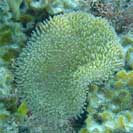
|

|
Sun anemone |

|
Sonnenanemone |

|
Caribische tapijtanemoon |

|
Anémone solaire |

|
Anémona solar |

|
|
|
The tropical Atlantic |
|
Substrate and environment |
|
The species is generally attached to a reef
The species can be found between 1 and 10 Meters
Uncommon Species
|
|
General characteristics of the species |
|
Diameter of the polyp : 170 mm
Lives in partnership with one or more crustaceans
|
|
Relationship with humans |
The species is slightly irritant
The species is exploited in the following sector(s) :
- Aquarium enthusiasts.
|
|
Stichodactyla haddoni |
Distribution |

|

|
Haddon's sea anemone |

|
Teppichanemone |

|
Anemoon van Haddon |

|
Anémone de Haddon |

|
Anémona de Haddon |

|
Anemone di Haddon |
|
The tropical Pacific
The Red Sea
The Indian Ocean |
|
Substrate and environment |
|
The species is generally found in a sandy/silty area
The species can be found between 3 and 40 Meters
Uncommon Species
|
|
General characteristics of the species |
|
Maximum size of the colony : 80 cm Diameter of the polyp : 800 mm
The animal can show variable colouring
Lives in partnership with one or more fishes Lives in partnership with one or more crustaceans Lives in partnership with algae
|
|
Relationship with humans |
The species is slightly irritant
The species is exploited in the following sector(s) :
- Aquarium enthusiasts.
|
|
The species can be confused with other species of similar appearance! |
|
Stichodactyla gigantea |
Distribution |

|

|
Giant carpet anemone |

|
Riesenanemone |

|
|

|
Anémone carpette géante |

|
|

|
|
|
The tropical Pacific
The Red Sea
The Indian Ocean |
|
Substrate and environment |
|
The species is generally found in a sandy/silty area
The species can be found between 1 and 30 Meters
Common species.
|
|
General characteristics of the species |
|
Diameter of the polyp : 1200 mm
The animal can show variable colouring
Lives in partnership with one or more fishes Lives in partnership with one or more crustaceans Lives in partnership with algae
|
|
Relationship with humans |
The species is not irritant
The species is exploited in the following sector(s) :
- Aquarium enthusiasts.
|
|
The species can be confused with other species of similar appearance! |
|
Telmatactis cricoides |
Distribution |

|

|
Club-tipped anemone |

|
Keunlenanemone |

|
|

|
Anémone américaine |

|
Anemona de mazas |

|
|
|
The tropical Atlantic
The temperate Atlantic
The Mediterranean |
|
Substrate and environment |
|
The species is generally attached to a reef
The species can be found between 0 and 60 Meters
Common species.
|
|
General characteristics of the species |
|
Diameter of the polyp : 200 mm
The animal can show variable colouring
Lives in partnership with one or more crustaceans
|
|
Relationship with humans |
|
The species is not irritant
|
|
Urticina felina |
Distribution |

|

|
Dahlia anemone |

|
Seedahlie |

|
Zeedahlia |

|
Dahlia de mer |

|
Dalia de Mar |

|
|
|
The temperate Atlantic |
|
Substrate and environment |
|
The species is generally attached to a reef
The species can be found between 0 and 100 Meters
Uncommon Species
|
|
General characteristics of the species |
|
Diameter of the polyp : 200 mm
The animal can show variable colouring
|
|
Relationship with humans |
The species is not irritant
The species is exploited in the following sector(s) :
- Aquarium enthusiasts.
|
|
Zoanthus pulchellus |
Distribution |
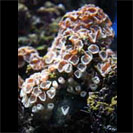
|

|
Mat zoanthid |

|
Graue Krusten-anemone |

|
Tapijtkorstanemoon |

|
Zoanthaire tapis |

|
Zoantario alfombra |

|
|
|
The tropical Atlantic |
|
Substrate and environment |
|
The species is generally attached to a reef
Often in a cavity or under an overhang
The species can be found between 2 and 20 Meters
Common species.
|
|
General characteristics of the species |
|
Diameter of the polyp : 12 mm
|
|
Relationship with humans |
The species is not irritant
The species is exploited in the following sector(s) :
- Aquarium enthusiasts.
|
|
The species can be confused with other species of similar appearance! |
|
Acropora cervicornis |
Distribution |
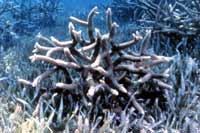
|

|
Staghorn coral |

|
Hirschgeweih-Koralle |

|
Geweikoraal |

|
Acropore bois-de-cerf |

|
Coral cuerno de ciervo |

|
|
|
The tropical Atlantic
The tropical Pacific |
|
Substrate and environment |
|
The species is generally attached to a reef
The species can be found between 0 and 55 Meters
Uncommon Species
|
|
General characteristics of the species |
|
Maximum size of the colony : 300 cm Diameter of the polyp : 1 mm
Animal with fast growth
Lives in partnership with algae
|
|
Relationship with humans |
The species is not irritant
The species is exploited in the following sector(s) :
- Aquarium enthusiasts.
|
|
Acropora palmata |
Distribution |
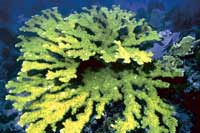
|

|
Elkhorn coral |

|
Elchgeweih Koralle |

|
Elandsgeweikoraal |

|
Acropore bois d'élan |

|
Coral cuerno de arce |

|
|
|
The tropical Atlantic |
|
Substrate and environment |
|
The species is generally attached to a reef
Generally in an area where there is a current
The species can be found between 0 and 18 Meters
Uncommon Species
|
|
General characteristics of the species |
|
Maximum size of the colony : 400 cm Diameter of the polyp : 1 mm
Lives in partnership with algae
|
|
Relationship with humans |
The species is not irritant
The species is exploited in the following sector(s) :
- Aquarium enthusiasts.
|
|
Acropora humilis |
Distribution |

|

|
Finger-acropora |

|
Kleine Tischkoralle |

|
|

|
Acropore digitiforme |

|
Acrópora digitiforme |

|
Acropora verde delle Fiji |
|
The tropical Pacific
The Red Sea
The Indian Ocean |
|
Substrate and environment |
|
The species is generally attached to a reef
The species can be found between 0 and 15 Meters
Very common species.
|
|
General characteristics of the species |
|
Maximum size of the colony : 80 cm Diameter of the polyp : 2 mm
The animal can show variable colouring
Lives in partnership with algae
|
|
Relationship with humans |
The species is not irritant
The species is exploited in the following sector(s) :
- Aquarium enthusiasts.
The species is classified asVulnerable
|
|
The species can be confused with other species of similar appearance! |
|
Acropora pharaonis |
Distribution |

|

|
Giant table coral |

|
Pharao - Geweihkoralle |

|
|

|
Acropore tabulaire géant |

|
Coral mesa gigante |

|
Corallo tavolo |
|
The tropical Pacific
The Red Sea
The Indian Ocean |
|
Substrate and environment |
|
The species is generally attached to a reef
The species can be found between 2 and 30 Meters
Common species.
|
|
General characteristics of the species |
|
Maximum size of the colony : 500 cm
The animal can show variable colouring
Lives in partnership with algae
|
|
Relationship with humans |
The species is not irritant
The species is exploited in the following sector(s) :
- Aquarium enthusiasts.
The species is classified asVulnerable
|
|
The species can be confused with other species of similar appearance! |
|
Agaricia agaricites |
Distribution |
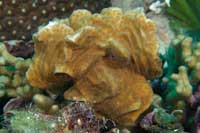
|

|
Lettuce coral |

|
Salatblatt-Koralle |

|
Slakoraal |

|
Corail-laitue |

|
Coral lechuga |

|
|
|
The tropical Atlantic |
|
Substrate and environment |
|
The species can be found between 0 and 50 Meters
Very common species.
|
|
General characteristics of the species |
|
Maximum size of the colony : 80 cm
The animal can show variable colouring The form of the animal can vary greatly
Lives in partnership with algae
|
|
Relationship with humans |
The species is not irritant
The species is exploited in the following sector(s) :
- Aquarium enthusiasts.
|
|
The species can be confused with other species of similar appearance! |
|
Agaricia grahamae |
Distribution |

|

|
Graham's sheet coral |

|
Graham-Salatkoralle |

|
Graham's plaatkoraal |

|
Corail à feuilles de Graham |

|
Coral laminado |

|
|
|
The tropical Atlantic |
|
Substrate and environment |
|
The species is generally attached to a reef
The species can be found between 10 and 80 Meters
Common species.
|
|
General characteristics of the species |
|
Maximum size of the colony : 150 cm
Lives in partnership with algae
|
|
Relationship with humans |
|
The species is not irritant
|
|
The species can be confused with other species of similar appearance! |
|
Agaricia undata |
Distribution |
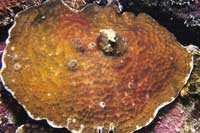
|

|
Scroll coral |

|
Eingerollte Koralle |

|
Spiraal-plaatkoraal |

|
Corail-plaque spiralé |

|
Coral enroscado |

|
|
|
The tropical Atlantic |
|
Substrate and environment |
|
The species is generally attached to a reef
The species can be found between 15 and 85 Meters
Uncommon Species
|
|
General characteristics of the species |
|
Maximum size of the colony : 180 cm
The animal can show variable colouring
Lives in partnership with algae
|
|
Relationship with humans |
|
The species is not irritant
|
|
The species can be confused with other species of similar appearance! |
|
Agaricia tenuifolia |
Distribution |
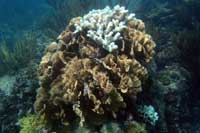
|

|
Thin leaf lettuce coral |

|
Dünnblättrige Salatblatt-Koralle |

|
Dun bladkoraal |

|
Corail à feuilles minces |

|
Coral de cintas |

|
|
|
The tropical Atlantic |
|
Substrate and environment |
|
The species is generally attached to a reef
Generally in an area where there is a current
The species can be found between 1 and 30 Meters
Uncommon Species
|
|
General characteristics of the species |
|
Maximum size of the colony : 300 cm
Lives in partnership with algae
|
|
Relationship with humans |
The species is not irritant
The species is exploited in the following sector(s) :
- Aquarium enthusiasts.
|
|
The species can be confused with other species of similar appearance! |
|
Agaricia lamarcki |
Distribution |
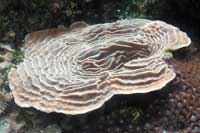
|

|
Whitestar sheet coral |

|
Lamarck-Salatkoralle |

|
Lamarck's plaat-koraal |

|
Agarice de lamarck |

|
Coral hoja de Lamarck |

|
|
|
The tropical Atlantic |
|
Substrate and environment |
|
The species is generally attached to a reef
The species can be found between 5 and 50 Meters
Common species.
|
|
General characteristics of the species |
|
Maximum size of the colony : 180 cm
Lives in partnership with algae
|
|
Relationship with humans |
The species is not irritant
The species is exploited in the following sector(s) :
- Aquarium enthusiasts.
|
|
The species can be confused with other species of similar appearance! |
|
Agaricia humilis |
Distribution |

|
|
The tropical Atlantic |
|
Substrate and environment |
|
The species is generally attached to a reef
The species can be found between 0 and 20 Meters
Uncommon Species
|
|
General characteristics of the species |
|
Maximum size of the colony : 150 cm
Lives in partnership with algae
|
|
Relationship with humans |
|
The species is not irritant
|
|
The species can be confused with other species of similar appearance! |
|
Astreopora myriophthalma |
Distribution |

|

|
Porous star coral |

|
Sternkorallen |

|
|

|
Acropore astréopora |

|
Coral estrella poroso |

|
Corallo fiore |
|
The tropical Pacific
The Red Sea
The Indian Ocean |
|
Substrate and environment |
|
The species is generally attached to a reef
The species can be found between 3 and 20 Meters
Very common species.
|
|
General characteristics of the species |
|
Maximum size of the colony : 70 cm Diameter of the polyp : 4 mm
Lives in partnership with algae
|
|
Relationship with humans |
|
The species is not irritant
|
|
The species can be confused with other species of similar appearance! |
|
Balanophyllia europaea |
Distribution |
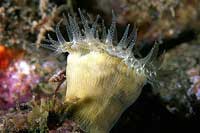
|

|
Scarlet coral |

|
Warzenkoralle |

|
Varkenstandkoraal |

|
Dent de cochon |

|
Coral taza |

|
Madrepora solitaria |
|
The Mediterranean |
|
Substrate and environment |
|
The species is generally attached to a reef
The species can be found between 0 and 40 Meters
Common species.
Endemic species.
|
|
General characteristics of the species |
|
Diameter of the polyp : 40 mm
Lives in partnership with algae
|
|
Relationship with humans |
The species is not irritant
The species is exploited in the following sector(s) :
- Aquarium enthusiasts.
|
|
Cladocora caespitosa |
Distribution |

|

|
Cladocora |

|
Rasenkoralle |

|
|

|
Cladocore |

|
Madrépora mediterránea |

|
Madrepora pagnotta |
|
The Mediterranean |
|
Substrate and environment |
|
The species is generally attached to a reef
The species can be found between 1 and 50 Meters
Uncommon Species
Endemic species.
|
|
General characteristics of the species |
|
Maximum size of the colony : 50 cm Diameter of the polyp : 5 mm
Lives in partnership with algae
|
|
Relationship with humans |
|
The species is not irritant
|
|
Colpophyllia natans |
Distribution |

|

|
Giant brain coral |

|
Riesen-Hirnkoralle |

|
Reuzenhersenkoraal |

|
Corail cerveau géant |

|
Coral cerebro gigante |

|
|
|
The tropical Atlantic |
|
Substrate and environment |
|
The species is generally attached to a reef
The species can be found between 1 and 60 Meters
Common species.
|
|
General characteristics of the species |
|
Maximum size of the colony : 220 cm Diameter of the polyp : 0 mm
Lives in partnership with algae
|
|
Relationship with humans |
|
The species is not irritant
|
|
The species can be confused with other species of similar appearance! |
|
Ctenactis crassa |
Distribution |

|

|
Elongated mushroom coral |

|
Grobe Pilzkoralle |

|
|

|
Corail-champignon à rayons |

|
Coral hongo |

|
Corallo fungo |
|
The tropical Pacific
The Red Sea
The Indian Ocean |
|
Substrate and environment |
|
The species is generally attached to a reef
The species can be found between 3 and 30 Meters
Uncommon Species
|
|
General characteristics of the species |
|
Maximum size of the colony : 48 cm Diameter of the polyp : 48 mm
Lives in partnership with algae
|
|
Relationship with humans |
|
The species is not irritant
|
|
The species can be confused with other species of similar appearance! |
|
Dendrogyra cylindrus |
Distribution |
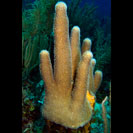
|

|
Pillar coral |

|
Säulenkoralle |

|
Zuil koraal |

|
Corail cierge |

|
Coral de columnas;Coral catedral |

|
|
|
The tropical Atlantic |
|
Substrate and environment |
|
The species is generally attached to a reef
The species can be found between 1 and 25 Meters
Rare species.
|
|
General characteristics of the species |
|
Maximum size of the colony : 350 cm
|
|
Relationship with humans |
The species is not irritant
The species is exploited in the following sector(s) :
- Aquarium enthusiasts.
|
|
Dendrophyllia ramea |
Distribution |

|

|
Yellow tree-coral |

|
Gelbe Baumkoralle |

|
Bloomkoraal |

|
Madréporaire arborescent |

|
Madrepora arborescente |

|
Madrepora arborescente |
|
The temperate Atlantic
The Mediterranean |
|
Substrate and environment |
|
The species is generally attached to a reef
The species can be found between 30 and 1500 Meters
Uncommon Species
|
|
General characteristics of the species |
|
Maximum size of the colony : 100 cm Diameter of the polyp : 4 mm
The animal can show variable colouring
|
|
Relationship with humans |
|
The species is not irritant
|
|
The species can be confused with other species of similar appearance! |
|
Dichocoenia stokesi |
Distribution |
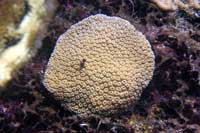
|

|
Elliptical star coral |

|
Stern-Ellipsen Koralle |

|
Elliptisch ster-koraal |

|
Corail à étoiles elliptiques |

|
Coral de cálices largos |

|
|
|
The tropical Atlantic |
|
Substrate and environment |
|
The species is generally attached to a reef
The species can be found between 4 and 80 Meters
Common species.
|
|
General characteristics of the species |
|
Maximum size of the colony : 50 cm
The form of the animal can vary greatly
Lives in partnership with algae
|
|
Relationship with humans |
The species is not irritant
The species is exploited in the following sector(s) :
- Aquarium enthusiasts.
|
|
The species can be confused with other species of similar appearance! |
|
Diploria strigosa |
Distribution |
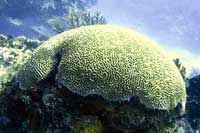
|

|
Common brain coral |

|
Gemeine Hirnkoralle |

|
Hersenkoraal |

|
Corail-cerveau commun |

|
Coral cerebro liso |

|
|
|
The tropical Atlantic |
|
Substrate and environment |
|
The species is generally attached to a reef
The species can be found between 1 and 45 Meters
Very common species.
|
|
General characteristics of the species |
|
Maximum size of the colony : 180 cm Diameter of the polyp : 0 mm
The form of the animal can vary greatly
Lives in partnership with algae
|
|
Relationship with humans |
The species is not irritant
The species is exploited in the following sector(s) :
- Aquarium enthusiasts.
|
|
The species can be confused with other species of similar appearance! |
|
Diploria clivosa |
Distribution |
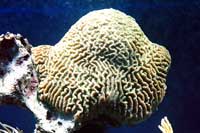
|

|
Knobby brain coral |

|
Knorrige Hirnkoralle |

|
Knobbelig hersenkoraal |

|
Corail cerveau bosselé |

|
Coral cerebro tuberoso |

|
|
|
The tropical Atlantic |
|
Substrate and environment |
|
The species is generally attached to a reef
The species can be found between 0 and 45 Meters
Common species.
|
|
General characteristics of the species |
|
Maximum size of the colony : 120 cm Diameter of the polyp : 5 mm
The form of the animal can vary greatly
Lives in partnership with algae
|
|
Relationship with humans |
The species is not irritant
The species is exploited in the following sector(s) :
- Aquarium enthusiasts.
|
|
The species can be confused with other species of similar appearance! |
|
Diploria labyrinthiformis |
Distribution |
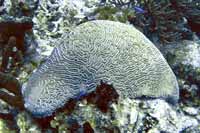
|

|
Grooved brain coral |

|
Labyrinth-Hirnkoralle |

|
Doolhofhersenkoraal |

|
Corail cerveau labyrinthe |

|
Coral cerebro surcado |

|
|
|
The tropical Atlantic |
|
Substrate and environment |
|
The species is generally attached to a reef
The species can be found between 1 and 40 Meters
Uncommon Species
|
|
General characteristics of the species |
|
Maximum size of the colony : 120 cm Diameter of the polyp : 3 mm
The animal can show variable colouring
Lives in partnership with algae
|
|
Relationship with humans |
The species is not irritant
The species is exploited in the following sector(s) :
- Aquarium enthusiasts.
|
|
Eusmilia fastigiata |
Distribution |

|

|
Smooth flower coral |

|
Blumen-Koralle |

|
Bloemkoraal |

|
Corail fleur |

|
Coral ramillete |

|
|
|
The tropical Atlantic |
|
Substrate and environment |
|
The species is generally attached to a reef
Often in a cavity or under an overhang
The species can be found between 1 and 65 Meters
Common species.
|
|
General characteristics of the species |
|
Maximum size of the colony : 60 cm Diameter of the polyp : 30 mm
The animal can show variable colouring
Lives in partnership with algae
|
|
Relationship with humans |
The species is not irritant
The species is exploited in the following sector(s) :
- Aquarium enthusiasts.
|
|
Favia fragum |
Distribution |
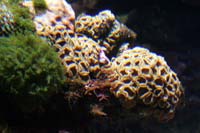
|

|
Golfball coral |

|
Golfballkoralle |

|
Golfbalkoraal |

|
Corail balle de golf |

|
Cupulita de coral;Bola de golf |

|
|
|
The tropical Atlantic |
|
Substrate and environment |
|
The species is generally attached to a reef
The species can be found between 1 and 30 Meters
Common species.
|
|
General characteristics of the species |
|
Maximum size of the colony : 4 cm Diameter of the polyp : 7 mm
The animal can show variable colouring
Lives in partnership with algae
|
|
Relationship with humans |
|
The species is not irritant
|
|
Favia favus |
Distribution |

|

|
Head coral |

|
Knopf-Koralle |

|
|

|
Favia vrai |

|
Coral mosaico |

|
Corallo mosaico |
|
The tropical Pacific
The Red Sea
The Indian Ocean |
|
Substrate and environment |
|
The species is generally attached to a reef
The species can be found between 1 and 50 Meters
Common species.
|
|
General characteristics of the species |
|
Maximum size of the colony : 100 cm Diameter of the polyp : 12 mm
The animal can show variable colouring
Lives in partnership with algae
|
|
Relationship with humans |
The species is not irritant
The species is exploited in the following sector(s) :
- Aquarium enthusiasts.
|
|
The species can be confused with other species of similar appearance! |
|
Favia stelligera |
Distribution |

|

|
Knob coral |

|
Kleine Sterkoralle |

|
|

|
Favia étoilée |

|
Coral estrellado |

|
Corallo a stella |
|
The tropical Pacific
The Red Sea
The Indian Ocean |
|
Substrate and environment |
|
The species is generally attached to a reef
The species can be found between 1 and 40 Meters
Common species.
|
|
General characteristics of the species |
|
Maximum size of the colony : 100 cm Diameter of the polyp : 8 mm
The animal can show variable colouring The form of the animal can vary greatly
Lives in partnership with algae
|
|
Relationship with humans |
The species is not irritant
The species is exploited in the following sector(s) :
- Aquarium enthusiasts.
|
|
The species can be confused with other species of similar appearance! |
|
Favia lacuna |
Distribution |

|

|
Lacuna coral |

|
olivfarbene Steinkoralle |

|
|

|
Madréporaire lacune |

|
Coral brecha |

|
Favia giallo-verde |
|
The Red Sea
The Indian Ocean |
|
Substrate and environment |
|
The species is generally attached to a reef
The species can be found between 1 and 30 Meters
Common species.
Endemic species.
|
|
General characteristics of the species |
|
Maximum size of the colony : 120 cm
Lives in partnership with algae
|
|
Relationship with humans |
|
The species is not irritant
|
|
The species can be confused with other species of similar appearance! |
|
Favia gravida |
Distribution |

|
|
The tropical Atlantic |
|
Substrate and environment |
|
The species is generally attached to a reef
The species can be found between 0 and 18 Meters
Common species.
|
|
General characteristics of the species |
|
Maximum size of the colony : 25 cm
Lives in partnership with algae
|
|
Relationship with humans |
|
The species is not irritant
|
|
Galaxea fascicularis |
Distribution |

|

|
Crystal coral |

|
RasenKoralle |

|
Sterkeltjeskoraal |

|
corail piquant |

|
Coral galaxia |

|
Madrepora erbosa |
|
The tropical Pacific
The Red Sea
The Indian Ocean |
|
Substrate and environment |
|
The species is generally attached to a reef
The species can be found between 3 and 30 Meters
Common species.
|
|
General characteristics of the species |
|
Maximum size of the colony : 500 cm Diameter of the polyp : 15 mm
The animal can show variable colouring
Lives in partnership with algae
|
|
Relationship with humans |
The species is not irritant
The species is exploited in the following sector(s) :
- Aquarium enthusiasts.
|
|
Goniastrea edwardsi |
Distribution |

|

|
Lesser star coral |

|
Edwards Sternkoralle |

|
|

|
Corail étoilé |

|
Estrella de coral |

|
Madrepora comune |
|
The tropical Pacific
The Red Sea
The Indian Ocean |
|
Substrate and environment |
|
The species is generally attached to a reef
The species can be found between 1 and 30 Meters
Very common species.
|
|
General characteristics of the species |
|
Maximum size of the colony : 100 cm
Lives in partnership with algae
|
|
Relationship with humans |
The species is not irritant
The species is exploited in the following sector(s) :
- Aquarium enthusiasts.
|
|
The species can be confused with other species of similar appearance! |
|
Goniopora planulata |
Distribution |

|

|
Flowerpot coral |

|
Krustige Margaritenkoralle |

|
|

|
Corail margueritte |

|
Coral maceta |

|
Corallo margherita |
|
The tropical Pacific
The Red Sea
The Indian Ocean |
|
Substrate and environment |
|
The species is generally attached to a reef
The species can be found between 0 and 35 Meters
Common species.
|
|
General characteristics of the species |
|
Maximum size of the colony : 100 cm
Lives in partnership with algae
|
|
Relationship with humans |
The species is not irritant
The species is exploited in the following sector(s) :
- Aquarium enthusiasts.
The species is classified asVulnerable
|
|
The species can be confused with other species of similar appearance! |
|
Isophyllia sinuosa |
Distribution |
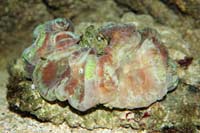
|

|
sinuous cactus coral |

|
Gewellte Kaktuskoralle |

|
Bochtig cactuskoraal |

|
Corail-cactus sinueux |

|
Coral cacto sinuoso |

|
|
|
The tropical Atlantic |
|
Substrate and environment |
|
The species is generally attached to a reef
The species can be found between 1 and 30 Meters
Uncommon Species
|
|
General characteristics of the species |
|
Maximum size of the colony : 20 cm
The animal can show variable colouring
Lives in partnership with algae
|
|
Relationship with humans |
The species is not irritant
The species is exploited in the following sector(s) :
- Aquarium enthusiasts.
|
|
The species can be confused with other species of similar appearance! |
|
Leptopsammia pruvoti |
Distribution |

|

|
Sunset Cup Coral |

|
Gelbe Steinkoralle |

|
Geel steenkoraal |

|
Corail jaune solitaire |

|
Madrépora amarilla |

|
Madrepora gialla |
|
The temperate Atlantic
The Mediterranean |
|
Substrate and environment |
|
The species is generally attached to a reef
Often in a cavity or under an overhang
The species can be found between 5 and 70 Meters
Uncommon Species
|
|
General characteristics of the species |
|
Diameter of the polyp : 30 mm
|
|
Relationship with humans |
|
The species is not irritant
|
|
The species can be confused with other species of similar appearance! |
|
Leptoseris yabei |
Distribution |

|

|
Porcelain corail |

|
Septen - Koralle |

|
|

|
Corail porcelaine |

|
Coral incrustante laminar |

|
Corallo ventaglio |
|
The tropical Pacific
The Red Sea
The Indian Ocean |
|
Substrate and environment |
|
The species is generally attached to a reef
The species can be found between 6 and 20 Meters
Uncommon Species
|
|
General characteristics of the species |
|
Maximum size of the colony : 100 cm
Lives in partnership with algae
|
|
Relationship with humans |
|
The species is not irritant
The species is classified asVulnerable
|
|
The species can be confused with other species of similar appearance! |
|
Lobophyllia hemprichii |
Distribution |

|

|
Largebrain root coral |

|
Gefaltete Becherkoralle |

|
|

|
Corail denté |

|
Coral cerebro lobulado |

|
Madrepora cervello largo |
|
The tropical Pacific
The Red Sea
The Indian Ocean |
|
Substrate and environment |
|
The species is generally attached to a reef
The species can be found between 6 and 40 Meters
Common species.
|
|
General characteristics of the species |
|
Maximum size of the colony : 500 cm Diameter of the polyp : 50 mm
The animal can show variable colouring The form of the animal can vary greatly
Lives in partnership with algae
|
|
Relationship with humans |
The species is not irritant
The species is exploited in the following sector(s) :
- Aquarium enthusiasts.
|
|
The species can be confused with other species of similar appearance! |
|
Madracis mirabilis |
Distribution |
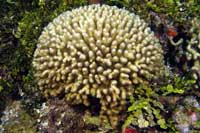
|

|
Yellow pencil coral |

|
Gelbpinsel-Koralle |

|
Geel vingerkoraal |

|
Corail digité jaune |

|
Coral cerillas |

|
|
|
The tropical Atlantic |
|
Substrate and environment |
|
The species is generally attached to a reef
Generally in an area where there is a current
The species can be found between 1 and 65 Meters
Common species.
|
|
General characteristics of the species |
|
Maximum size of the colony : 120 cm Diameter of the polyp : 2 mm
Animal with fast growth
Lives in partnership with algae
|
|
Relationship with humans |
|
The species is not irritant
|
|
Madracis formosa |
Distribution |

|

|
Eight-ray finger coral |

|
Achtstrahlige Finger-Koralle |

|
Vingerknobbbel-koraal |

|
Corail digité à huit septes |

|
Coral Cacto |

|
|
|
The tropical Atlantic |
|
Substrate and environment |
|
The species is generally attached to a reef
The species can be found between 20 and 70 Meters
Common species.
|
|
General characteristics of the species |
|
Maximum size of the colony : 150 cm Diameter of the polyp : 2 mm
The animal can show variable colouring
|
|
Relationship with humans |
The species is not irritant
The species is exploited in the following sector(s) :
- Aquarium enthusiasts.
|
|
Meandrina meandrites |
Distribution |

|

|
Maze coral |

|
Irrgarten-Koralle |

|
Doolhofkoraal |

|
Méandrine |

|
Coral cerebro ondulado |

|
|
|
The tropical Atlantic |
|
Substrate and environment |
|
The species is generally attached to a reef
The species can be found between 1 and 70 Meters
Uncommon Species
|
|
General characteristics of the species |
|
Maximum size of the colony : 90 cm Diameter of the polyp : 10 mm
The animal can show variable colouring The form of the animal can vary greatly
Lives in partnership with algae
|
|
Relationship with humans |
The species is not irritant
The species is exploited in the following sector(s) :
- Aquarium enthusiasts.
|
|
Montastrea cavernosa |
Distribution |
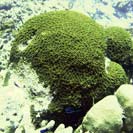
|

|
Great star coral, Large star coral |

|
Grosse Sternkoralle |

|
Grof sterkoraal |

|
Corail montagneux |

|
Coral cavernoso |

|
Corallo stellato caraibico |
|
The tropical Atlantic |
|
Substrate and environment |
|
The species is generally attached to a reef
The species can be found between 2 and 100 Meters
Common species.
|
|
General characteristics of the species |
|
Maximum size of the colony : 250 cm Diameter of the polyp : 15 mm
The animal can show variable colouring
Lives in partnership with algae
|
|
Relationship with humans |
The species is not irritant
The species is exploited in the following sector(s) :
- Aquarium enthusiasts.
|
|
Montastrea annularis |
Distribution |

|

|
Boulder star coral |

|
Block-Sternkoralle |

|
Kinderhoofdjeskoraal |

|
Corail montagneux à petits polypes;Corail étoilé massif |

|
Coral montañoso |

|
|
|
The tropical Atlantic |
|
Substrate and environment |
|
The species is generally attached to a reef
The species can be found between 2 and 40 Meters
Very common species.
|
|
General characteristics of the species |
|
Maximum size of the colony : 300 cm Diameter of the polyp : 3 mm
The form of the animal can vary greatly
Lives in partnership with algae
|
|
Relationship with humans |
The species is not irritant
The species is exploited in the following sector(s) :
- Aquarium enthusiasts.
|
|
The species can be confused with other species of similar appearance! |
|
Mussa angulosa |
Distribution |
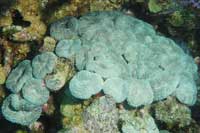
|

|
Spiny flower coral |

|
Stachelige Blumenkoralle |

|
Stekelig bloemkoraal |

|
Corail fleur épineux |

|
Coral florido |

|
|
|
The tropical Atlantic |
|
Substrate and environment |
|
The species is generally attached to a reef
The species can be found between 2 and 60 Meters
Uncommon Species
|
|
General characteristics of the species |
|
Maximum size of the colony : 60 cm Diameter of the polyp : 100 mm
The animal can show variable colouring
Lives in partnership with algae
|
|
Relationship with humans |
The species is not irritant
The species is exploited in the following sector(s) :
- Aquarium enthusiasts.
|
|
Mussismilia harttii |
Distribution |

|
|
|
|
Substrate and environment |
|
The species is generally attached to a reef
Common species.
Endemic species.
|
|
General characteristics of the species |
|
Maximum size of the colony : 20 cm
Lives in partnership with algae
|
|
Relationship with humans |
The species is not irritant
The species is exploited in the following sector(s) :
- Aquarium enthusiasts.
|
|
Mussismilia hispida |
Distribution |

|
|
|
|
Substrate and environment |
|
The species is generally attached to a reef
The species can be found between 0 and 20 Meters
Uncommon Species
Endemic species.
|
|
General characteristics of the species |
|
Maximum size of the colony : 40 cm
Lives in partnership with one or more fishes Lives in partnership with one or more crustaceans Lives in partnership with algae
|
|
Relationship with humans |
|
The species is not irritant
|
|
Mycetophyllia ferox |
Distribution |

|

|
Rough cactus coral |

|
Rauhe Kaktuskoralle |

|
Ruw zwamkoraal |

|
Corail cactus rugueux |

|
Coral hongo surcado |

|
|
|
The tropical Atlantic |
|
Substrate and environment |
|
The species is generally attached to a reef
Generally in an area where there is a current
The species can be found between 10 and 40 Meters
Uncommon Species
|
|
General characteristics of the species |
|
Maximum size of the colony : 60 cm
The animal can show variable colouring
Lives in partnership with algae
|
|
Relationship with humans |
|
The species is not irritant
|
|
Oculina tenella |
Distribution |
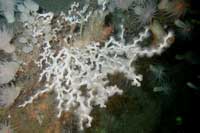
|

|
Delicate ivory bush coral |

|
Zarte Elfenbeinerne Busch-Koralle |

|
Fijne ivoren struik koraal |

|
Oculine délicate |

|
coral arbusto delicado de marfil |

|
|
|
The tropical Atlantic |
|
Substrate and environment |
|
The species is generally attached to a reef
The species can be found between 18 and 76 Meters
Rare species.
|
|
General characteristics of the species |
|
Maximum size of the colony : 12 cm Diameter of the polyp : 3 mm
|
|
Relationship with humans |
|
The species is not irritant
|
|
Oculina diffusa |
Distribution |

|

|
Diffuse ivory bush coral |

|
Verbreitet Elfenbeinerne Busch-Koralle |

|
Verward ivoren struik koraal |

|
Oculine diffuse |

|
Coral arbusto difuso de marfil |

|
|
|
The tropical Atlantic |
|
Substrate and environment |
|
The species is generally attached to a reef
The species can be found between 1 and 25 Meters
Common species.
|
|
General characteristics of the species |
|
Maximum size of the colony : 30 cm Diameter of the polyp : 6 mm
|
|
Relationship with humans |
|
The species is not irritant
|
|
Pachyseris speciosa |
Distribution |

|

|
Castle coral |

|
RinnenKoralle |

|
|

|
Pachyséris lamellaire |

|
castillo de Coral |

|
Corallo laminare |
|
The tropical Pacific
The Red Sea
The Indian Ocean |
|
Substrate and environment |
|
The species is generally attached to a reef
The species can be found between 4 and 35 Meters
Common species.
|
|
General characteristics of the species |
|
Maximum size of the colony : 300 cm
The animal can show variable colouring
Lives in partnership with algae
|
|
Relationship with humans |
|
The species is not irritant
|
|
The species can be confused with other species of similar appearance! |
|
Palythoa caribaeorum |
Distribution |

|
|
The tropical Atlantic |
|
Substrate and environment |
|
The species is generally attached to a reef
The species can be found between 0 and 20 Meters
Very common species.
|
|
General characteristics of the species |
|
Maximum size of the colony : 90 cm
Lives in partnership with algae
|
|
Relationship with humans |
|
The species is not irritant
|
|
Parazoanthus swiftii |
Distribution |

|

|
Golden zoanthid |

|
Goldene Krustenanemone |

|
Gouden sponskorstanemoon |

|
Zoanthaire des éponges doré |

|
Zoantario de esponjas dorado |

|
|
|
The tropical Atlantic |
|
Substrate and environment |
|
The species is generally found in a sandy/silty area
The species can be found between 2 and 45 Meters
Common species.
|
|
General characteristics of the species |
|
Maximum size of the colony : 10 cm Diameter of the polyp : 5 mm
|
|
Relationship with humans |
The species is not irritant
The species is exploited in the following sector(s) :
- Aquarium enthusiasts.
|
|
Platygyra daedalea |
Distribution |

|

|
Maze brain coral |

|
Gemeine Hirnkoralle |

|
|

|
Corail cerveau dédale |

|
Coral cerebro verde |

|
Madrepora cervello |
|
The tropical Pacific
The Red Sea
The Indian Ocean |
|
Substrate and environment |
|
The species is generally attached to a reef
The species can be found between 3 and 30 Meters
Common species.
|
|
General characteristics of the species |
|
Maximum size of the colony : 100 cm
Lives in partnership with algae
|
|
Relationship with humans |
The species is not irritant
The species is exploited in the following sector(s) :
- Aquarium enthusiasts.
|
|
The species can be confused with other species of similar appearance! |
|
Plerogyra sinuosa |
Distribution |

|

|
Bubble coral |

|
Blasenkorallen |

|
|

|
Corail à bulles sinueux |

|
Coral burbuja |

|
Corallo a bolle |
|
The tropical Pacific
The Red Sea
The Indian Ocean |
|
Substrate and environment |
|
The species is generally attached to a reef
Often in a cavity or under an overhang
The species can be found between 3 and 45 Meters
Uncommon Species
|
|
General characteristics of the species |
|
Maximum size of the colony : 200 cm Diameter of the polyp : 30 mm
The animal can show variable colouring
Lives in partnership with algae
|
|
Relationship with humans |
The species is slightly irritant
The species is exploited in the following sector(s) :
- Aquarium enthusiasts.
The species is classified asVulnerable
|
|
The species can be confused with other species of similar appearance! |
|
Pocillopora damicornis |
Distribution |

|

|
Cauliflower coral |

|
Himbeerkoralle |

|
|

|
corail chou-fleur |

|
Coral coliflor |

|
Madrepora lampone |
|
The tropical Pacific
The Red Sea
The Indian Ocean |
|
Substrate and environment |
|
The species is generally attached to a reef
The species can be found between 0 and 50 Meters
Very common species.
|
|
General characteristics of the species |
|
Maximum size of the colony : 30 cm Diameter of the polyp : 1 mm
The animal can show variable colouring
Lives in partnership with algae
|
|
Relationship with humans |
The species is not irritant
The species is exploited in the following sector(s) :
- Aquarium enthusiasts.
Used in the clothing, footwear or crafts industries for the manufacture of articles (jewellery, etc.).
|
|
The species can be confused with other species of similar appearance! |
|
Pocillopora verrucosa |
Distribution |

|

|
Rasp coral |

|
Buschkoralle |

|
|

|
Corail framboise |

|
Coral verrugoso |

|
Madrepora lampone |
|
The tropical Pacific
The Red Sea
The Indian Ocean |
|
Substrate and environment |
|
The species is generally attached to a reef
The species can be found between 0 and 35 Meters
Very common species.
|
|
General characteristics of the species |
|
Maximum size of the colony : 40 cm Diameter of the polyp : 1 mm
The animal can show variable colouring
Lives in partnership with algae
|
|
Relationship with humans |
The species is not irritant
The species is exploited in the following sector(s) :
- Aquarium enthusiasts.
Used in the clothing, footwear or crafts industries for the manufacture of articles (jewellery, etc.).
|
|
The species can be confused with other species of similar appearance! |
|
Porites porites |
Distribution |
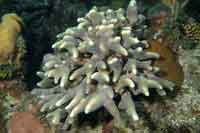
|

|
Finger coral |

|
Finger-Koralle |

|
Vingerkoraal |

|
Corail digité |

|
Coral digitado romo |

|
|
|
The tropical Atlantic |
|
Substrate and environment |
|
The species is generally attached to a reef
The species can be found between 0 and 55 Meters
Very common species.
|
|
General characteristics of the species |
|
Maximum size of the colony : 150 cm
Lives in partnership with algae
|
|
Relationship with humans |
The species is not irritant
The species is exploited in the following sector(s) :
- Aquarium enthusiasts.
Used in the clothing, footwear or crafts industries for the manufacture of articles (jewellery, etc.).
|
|
The species can be confused with other species of similar appearance! |
|
Porites lutea |
Distribution |

|

|
Mountain coral |

|
Gelbe Rotmeerkoralle |

|
|

|
Corail poreux montagneux |

|
Coral montículo |

|
Madrepora viola |
|
The tropical Pacific
The Red Sea
The Indian Ocean |
|
Substrate and environment |
|
The species is generally attached to a reef
The species can be found between 1 and 35 Meters
Very common species.
|
|
General characteristics of the species |
|
Maximum size of the colony : 700 cm Diameter of the polyp : 2 mm
The animal can show variable colouring
Lives in partnership with algae
|
|
Relationship with humans |
The species is not irritant
The species is exploited in the following sector(s) :
- Aquarium enthusiasts.
Used in the clothing, footwear or crafts industries for the manufacture of articles (jewellery, etc.).
|
|
The species can be confused with other species of similar appearance! |
|
Porites astreoides |
Distribution |

|
|
The tropical Atlantic |
|
Substrate and environment |
|
The species is generally attached to a reef
The species can be found between 0 and 50 Meters
Common species.
|
|
General characteristics of the species |
|
Maximum size of the colony : 60 cm
Animal with fast growth
Lives in partnership with algae
|
|
Relationship with humans |
|
The species is not irritant
|
|
Scolymia wellsi |
Distribution |

|
|
The tropical Atlantic |
|
Substrate and environment |
|
The species is generally attached to a reef
The species can be found between 0 and 100 Meters
Uncommon Species
|
|
General characteristics of the species |
|
Maximum size of the colony : 10 cm
Lives in partnership with algae
|
|
Relationship with humans |
The species is not irritant
The species is exploited in the following sector(s) :
- Aquarium enthusiasts.
|
|
Seriatopora hystrix |
Distribution |

|

|
Needle Coral |

|
Dornige Buschkoralle |

|
|

|
Corail-aiguille |

|
Coral nido de pajaro |

|
Corallo nido di uccello |
|
The tropical Pacific
The Red Sea
The Indian Ocean |
|
Substrate and environment |
|
The species is generally attached to a reef
The species can be found between 0 and 30 Meters
Common species.
|
|
General characteristics of the species |
|
Maximum size of the colony : 30 cm Diameter of the polyp : 1 mm
Lives in partnership with algae
|
|
Relationship with humans |
The species is not irritant
The species is exploited in the following sector(s) :
- Aquarium enthusiasts.
|
|
The species can be confused with other species of similar appearance! |
|
Siderastrea siderea |
Distribution |
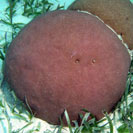
|

|
Massive starlet coral |

|
Sternchenkoralle |

|
Glad sterretjeskoraal |

|
Corail lisse à petites étoiles |

|
Coral de estrellitas liso |

|
|
|
The tropical Atlantic |
|
Substrate and environment |
|
The species is generally attached to a reef
The species can be found between 0 and 80 Meters
Common species.
|
|
General characteristics of the species |
|
Maximum size of the colony : 180 cm Diameter of the polyp : 4 mm
The animal can show variable colouring
Lives in partnership with algae
|
|
Relationship with humans |
The species is not irritant
The species is exploited in the following sector(s) :
- Aquarium enthusiasts.
|
|
The species can be confused with other species of similar appearance! |
|
Siderastrea stellata |
Distribution |

|
|
|
|
Substrate and environment |
|
The species is generally attached to a reef
The species can be found between 0 and 10 Meters
Common species.
Endemic species.
|
|
General characteristics of the species |
|
Maximum size of the colony : 15 cm
Lives in partnership with algae
|
|
Relationship with humans |
|
The species is not irritant
|
|
Stylophora pistillata |
Distribution |

|

|
Finger coral |

|
Griffel - Buschkoralle |

|
|

|
Corail digitiforme |

|
Coral pata de gato |

|
Corallo dito |
|
The tropical Pacific
The Red Sea
The Indian Ocean |
|
Substrate and environment |
|
The species is generally attached to a reef
The species can be found between 0 and 15 Meters
Very common species.
|
|
General characteristics of the species |
|
Maximum size of the colony : 30 cm Diameter of the polyp : 1 mm
The animal can show variable colouring
Lives in partnership with algae
|
|
Relationship with humans |
The species is not irritant
The species is exploited in the following sector(s) :
- Aquarium enthusiasts.
|
|
The species can be confused with other species of similar appearance! |
|
Trachyphyllia geoffroyi |
Distribution |

|

|
Open Brain Coral |

|
Offene Hirnkoralle |

|
|

|
Corail cerveau ouvert |

|
Coral ondulante amarillo |

|
Corallo a cervello |
|
The tropical Pacific
The Red Sea
The Indian Ocean |
|
Substrate and environment |
|
The species is generally found in a sandy/silty area
The species can be found between 0 and 40 Meters
Uncommon Species
|
|
General characteristics of the species |
|
Maximum size of the colony : 20 cm
The animal can show variable colouring
Lives in partnership with algae
|
|
Relationship with humans |
The species is not irritant
The species is exploited in the following sector(s) :
- Aquarium enthusiasts.
The species is classified asVulnerable
|
|
The species can be confused with other species of similar appearance! |
|
Tubastraea coccinea |
Distribution |
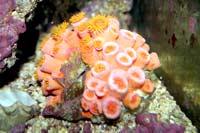
|

|
Orange cup coral |

|
Rote Kelchkoralle |

|
Oranje buiskoraal |

|
Tubastrée orange |

|
Coral de capa naranja |

|
Corallo arancione della tazza |
|
The tropical Atlantic
The tropical Pacific
The Red Sea
The Indian Ocean |
|
Substrate and environment |
|
The species is generally attached to a reef
Often in a cavity or under an overhang
The species can be found between 1 and 40 Meters
Uncommon Species
|
|
General characteristics of the species |
|
Maximum size of the colony : 35 cm Diameter of the polyp : 20 mm
|
|
Relationship with humans |
The species is not irritant
The species is exploited in the following sector(s) :
- Aquarium enthusiasts.
|
|
Turbinaria mesenterina |
Distribution |

|

|
Leafy cup coral |

|
Gewundene Kraterkoralle |

|
|

|
Corail salade |

|
Coral ondulante amarillo |

|
Corallo pagoda |
|
The tropical Pacific
The Red Sea
The Indian Ocean |
|
Substrate and environment |
|
The species is generally attached to a reef
The species can be found between 5 and 20 Meters
Common species.
|
|
General characteristics of the species |
|
Maximum size of the colony : 300 cm Diameter of the polyp : 3 mm
Lives in partnership with algae
|
|
Relationship with humans |
The species is not irritant
The species is exploited in the following sector(s) :
- Aquarium enthusiasts.
|
|
The species can be confused with other species of similar appearance! |
|
Zoanthus sociatus |
Distribution |

|

|
Green sea mat |

|
|

|
|

|
Anémone de mer tapis |

|
|

|
|
|
The tropical Atlantic
The tropical Pacific |
|
Substrate and environment |
|
The species is generally attached to a reef
The species can be found between 0 and 20 Meters
Very common species.
|
|
General characteristics of the species |
|
Lives in partnership with algae
|
|
Relationship with humans |
The species is not irritant
The species is exploited in the following sector(s) :
- Aquarium enthusiasts.
|
|
Antipathes caribbeana |
Distribution |
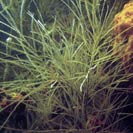
|

|
King's black coral |

|
Buschige Dörnchenkoralle |

|
Struikvormig zwart koraal |

|
Corail noir buissonnant |

|
Coral negro arborescente |

|
|
|
The tropical Atlantic |
|
Substrate and environment |
|
The species is generally attached to a reef
Generally in an area where there is a current
The species can be found between 15 and 100 Meters
Uncommon Species
|
|
General characteristics of the species |
|
Maximum size of the colony : 350 cm
The animal can show variable colouring
|
|
Relationship with humans |
The species is not irritant
The species is exploited in the following sector(s) :
Used in the clothing, footwear or crafts industries for the manufacture of articles (jewellery, etc.).
|
|
The species can be confused with other species of similar appearance! |
|
Antipathes pennacea |
Distribution |

|

|
Feather black coral |

|
Feder-Dörnchenkoralle |

|
Geveerd zwart koraal |

|
Corail noir plume |

|
Coral negro pluma |

|
|
|
The tropical Atlantic |
|
Substrate and environment |
|
The species is generally attached to a reef
Often in a cavity or under an overhang
The species can be found between 5 and 300 Meters
Uncommon Species
|
|
General characteristics of the species |
|
Maximum size of the colony : 150 cm
The animal can show variable colouring
|
|
Relationship with humans |
The species is not irritant
The species is exploited in the following sector(s) :
Used in the clothing, footwear or crafts industries for the manufacture of articles (jewellery, etc.).
|
|
Antipathes atlantica |
Distribution |
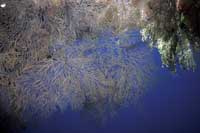
|

|
Grey sea fan black coral |

|
Graue Fächer-Dörnchenkoralle |

|
Grijze-waaier zwart koraal |

|
Corail noir à éventail gris |

|
Coral negro de abanicos grises |

|
|
|
The tropical Atlantic |
|
Substrate and environment |
|
The species is generally attached to a reef
Often in a cavity or under an overhang
The species can be found between 20 and 100 Meters
Uncommon Species
|
|
General characteristics of the species |
|
Maximum size of the colony : 120 cm
The animal can show variable colouring
|
|
Relationship with humans |
The species is not irritant
The species is exploited in the following sector(s) :
Used in the clothing, footwear or crafts industries for the manufacture of articles (jewellery, etc.).
|
|
Antipathes n. sp. |
Distribution |
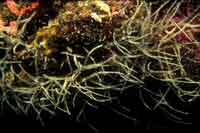
|

|
Scraggly black coral |

|
Zerfetzt Dörnchenkoralle |

|
Verscheurd swart koraal |

|
Corail noir déchiqueté |

|
Coral negro destrozado |

|
|
|
The tropical Atlantic |
|
Substrate and environment |
|
The species is generally attached to a reef
Often in a cavity or under an overhang
The species can be found between 18 and 75 Meters
Common species.
|
|
General characteristics of the species |
|
Maximum size of the colony : 30 cm
|
|
Relationship with humans |
|
The species is not irritant
|
|
The species can be confused with other species of similar appearance! |
|
Antipathes dichotoma |
Distribution |

|

|
Black coral |

|
Schwarze Koralle |

|
|

|
Corail noir |

|
|

|
|
|
The tropical Atlantic
The tropical Pacific
The Red Sea
The Indian Ocean
The Mediterranean |
|
Substrate and environment |
|
The species is generally attached to a reef
Generally in an area where there is a current
The species can be found between 10 and 50 Meters
|
|
General characteristics of the species |
|
Maximum size of the colony : 300 cm Diameter of the polyp : 2 mm
|
|
Relationship with humans |
The species is not irritant
The species is exploited in the following sector(s) :
Used in the clothing, footwear or crafts industries for the manufacture of articles (jewellery, etc.).
|
|
The species can be confused with other species of similar appearance! |
|
Cirrhipathes lutkeni |
Distribution |
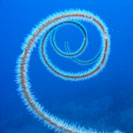
|

|
Wire coral |

|
Peitschenkoralle |

|
Ijzerdraadkoraal |

|
Corail fil de fer |

|
Coral alambre |

|
|
|
The tropical Atlantic |
|
Substrate and environment |
|
The species is generally attached to a reef
The species can be found between 15 and 125 Meters
Common species.
|
|
General characteristics of the species |
|
Maximum size of the colony : 450 cm
The animal can show variable colouring
|
|
Relationship with humans |
|
The species is not irritant
|
|
The species can be confused with other species of similar appearance! |
|
Cirripathes anguina |
Distribution |

|

|
Yellow wire coral |

|
|

|
|

|
Corail fil-de-fer tordu |

|
|

|
|
|
The tropical Pacific
The Red Sea
The Indian Ocean |
|
Substrate and environment |
|
The species is generally attached to a reef
The species can be found between 5 and 20 Meters
Common species.
|
|
General characteristics of the species |
|
Maximum size of the colony : 200 cm
|
|
Relationship with humans |
|
The species is not irritant
|
|
The species can be confused with other species of similar appearance! |
|
Acropora digitifera |
Distribution |

|

|
Finger acropora |

|
|

|
|

|
Acropore gigité |

|
|

|
|
|
The tropical Pacific
The Red Sea
The Indian Ocean |
|
Substrate and environment |
|
The species is generally attached to a reef
The species can be found between 1 and 20 Meters
Common species.
|
|
General characteristics of the species |
|
Maximum size of the colony : 60 cm Diameter of the polyp : 1 mm
The animal can show variable colouring
Lives in partnership with algae
|
|
Relationship with humans |
The species is not irritant
The species is exploited in the following sector(s) :
- Aquarium enthusiasts.
|
|
The species can be confused with other species of similar appearance! |
|
Acropora formosa |
Distribution |

|

|
Staghorn coral |

|
|

|
|

|
Acropore bois de cerf |

|
Coral candelabro |

|
|
|
The tropical Pacific
The Red Sea
The Indian Ocean |
|
Substrate and environment |
|
The species is generally attached to a reef
The species can be found between 2 and 30 Meters
Uncommon Species
|
|
General characteristics of the species |
|
Maximum size of the colony : 150 cm Diameter of the polyp : 1 mm
The animal can show variable colouring
Lives in partnership with algae
|
|
Relationship with humans |
The species is not irritant
The species is exploited in the following sector(s) :
- Aquarium enthusiasts.
The species is classified asVulnerable
|
|
The species can be confused with other species of similar appearance! |
|
Acropora latistella |
Distribution |

|

|
Wide star acropora |

|
|

|
|

|
Acropore tabulaire étoilé |

|
|

|
|
|
The tropical Pacific
The Red Sea
The Indian Ocean |
|
Substrate and environment |
|
The species is generally attached to a reef
The species can be found between 3 and 20 Meters
Common species.
|
|
General characteristics of the species |
|
Maximum size of the colony : 80 cm Diameter of the polyp : 1 mm
The animal can show variable colouring
|
|
Relationship with humans |
The species is not irritant
The species is exploited in the following sector(s) :
- Aquarium enthusiasts.
|
|
The species can be confused with other species of similar appearance! |
|
Acropora robusta |
Distribution |

|

|
Robust table coral |

|
|

|
|

|
Acropore tablulaire robuste |

|
|

|
|
|
The tropical Pacific
The Red Sea
The Indian Ocean |
|
Substrate and environment |
|
The species is generally attached to a reef
The species can be found between 3 and 10 Meters
Common species.
|
|
General characteristics of the species |
|
Maximum size of the colony : 120 cm Diameter of the polyp : 1 mm
The animal can show variable colouring
Lives in partnership with algae
|
|
Relationship with humans |
The species is not irritant
The species is exploited in the following sector(s) :
- Aquarium enthusiasts.
|
|
The species can be confused with other species of similar appearance! |
|
Acropora grandis |
Distribution |

|

|
Great staghorn coral |

|
|

|
|

|
Grand corail corne de cerf |

|
|

|
|
|
The tropical Pacific
The Red Sea
The Indian Ocean |
|
Substrate and environment |
|
The species is generally attached to a reef
Generally in an area where there is a current
The species can be found between 5 and 25 Meters
Common species.
|
|
General characteristics of the species |
|
Maximum size of the colony : 700 cm
Lives in partnership with algae
|
|
Relationship with humans |
|
The species is not irritant
|
|
The species can be confused with other species of similar appearance! |
|
Caryophyllia smithii |
Distribution |

|

|
Devonshire cup-coral |

|
Nelkenkoralle |

|
Anjelierkoraal |

|
Dent de chien |

|
Madrepora clavel |

|
|
|
The temperate Atlantic
The Mediterranean |
|
Substrate and environment |
|
The species is generally attached to a reef
The species can be found between 1 and 1000 Meters
Common species.
|
|
General characteristics of the species |
|
Diameter of the polyp : 25 mm
The animal can show variable colouring
|
|
Relationship with humans |
|
The species is not irritant
|
|
The species can be confused with other species of similar appearance! |
|
Diploastrea heliopora |
Distribution |

|

|
Honeycomb coral |

|
|

|
|

|
Corail rayonnant |

|
|

|
|
|
The tropical Pacific
The Red Sea
The Indian Ocean |
|
Substrate and environment |
|
The species is generally attached to a reef
The species can be found between 0 and 30 Meters
Uncommon Species
|
|
General characteristics of the species |
|
Maximum size of the colony : 700 cm Diameter of the polyp : 3 mm
The animal can show variable colouring
Lives in partnership with algae
|
|
Relationship with humans |
|
The species is not irritant
The species is classified asVulnerable
|
|
The species can be confused with other species of similar appearance! |
|
Euphyllia ancora |
Distribution |

|

|
Anchor coral |

|
Sicheltentakel-Koralle |

|
|

|
Corail à croissants |

|
Carece en castellano |

|
Madrepora ancora |
|
The tropical Pacific
The Indian Ocean |
|
Substrate and environment |
|
The species is generally attached to a reef
The species can be found between 6 and 50 Meters
Uncommon Species
|
|
General characteristics of the species |
|
Maximum size of the colony : 100 cm
The animal can show variable colouring
Lives in partnership with algae
|
|
Relationship with humans |
The species is not irritant
The species is exploited in the following sector(s) :
- Aquarium enthusiasts.
The species is classified asVulnerable
|
|
Favites flexuosa |
Distribution |

|

|
Flexuous Moon coral |

|
|

|
|

|
Corail tortueux |

|
|

|
|
|
The tropical Pacific
The Red Sea
The Indian Ocean |
|
Substrate and environment |
|
The species is generally attached to a reef
The species can be found between 0 and 40 Meters
Common species.
|
|
General characteristics of the species |
|
Maximum size of the colony : 120 cm Diameter of the polyp : 20 mm
The animal can show variable colouring
Lives in partnership with algae
|
|
Relationship with humans |
The species is not irritant
The species is exploited in the following sector(s) :
- Aquarium enthusiasts.
The species is classified asVulnerable
|
|
The species can be confused with other species of similar appearance! |
|
Fungia fungites |
Distribution |

|

|
Mushroom coral |

|
|

|
|

|
Corail champignon |

|
|

|
|
|
The tropical Pacific
The Red Sea
The Indian Ocean |
|
Substrate and environment |
|
The species is generally attached to a reef
The species can be found between 1 and 25 Meters
Very common species.
|
|
General characteristics of the species |
|
Maximum size of the colony : 30 cm Diameter of the polyp : 30 mm
The animal can show variable colouring
Lives in partnership with algae
|
|
Relationship with humans |
The species is not irritant
The species is exploited in the following sector(s) :
- Aquarium enthusiasts.
|
|
The species can be confused with other species of similar appearance! |
|
Goniopora columna |
Distribution |

|

|
Columna-goniopora |

|
|

|
|

|
Goniopore en colones |

|
|

|
|
|
The tropical Pacific
The Red Sea
The Indian Ocean |
|
Substrate and environment |
|
The species is generally attached to a reef
The species can be found between 1 and 35 Meters
Common species.
|
|
General characteristics of the species |
|
Maximum size of the colony : 60 cm Diameter of the polyp : 15 mm
The animal can show variable colouring
Lives in partnership with algae
|
|
Relationship with humans |
The species is not irritant
The species is exploited in the following sector(s) :
- Aquarium enthusiasts.
The species is classified asVulnerable
|
|
Leptoria phrygia |
Distribution |

|

|
Closed brain coral |

|
Großpolypige Steinkoralle |

|
|

|
Faux corail cerveau |

|
Coral cerebro cerrado |

|
Corallo cervello chiuso |
|
The tropical Pacific
The Red Sea
The Indian Ocean |
|
Substrate and environment |
|
The species is generally attached to a reef
The species can be found between 1 and 30 Meters
Common species.
|
|
General characteristics of the species |
|
Maximum size of the colony : 150 cm
The animal can show variable colouring
Lives in partnership with algae
|
|
Relationship with humans |
|
The species is not irritant
The species is classified asVulnerable
|
|
The species can be confused with other species of similar appearance! |
|
Montipora digitata |
Distribution |

|

|
Finger coral |

|
|

|
|

|
Corail digité |

|
|

|
|
|
The tropical Pacific
The Indian Ocean |
|
Substrate and environment |
|
The species is generally attached to a reef
Generally in an area where there is a current
The species can be found between 0 and 15 Meters
Common species.
|
|
General characteristics of the species |
|
Maximum size of the colony : 50 cm Diameter of the polyp : 1 mm
The animal can show variable colouring Animal with fast growth
Lives in partnership with algae
|
|
Relationship with humans |
The species is not irritant
The species is exploited in the following sector(s) :
- Aquarium enthusiasts.
|
|
The species can be confused with other species of similar appearance! |
|
Mycedium elephantotus |
Distribution |

|

|
Elephant-skin coral |

|
Elefantenhaut-Koralle |

|
|

|
Corail peau d'éléphant |

|
|

|
|
|
The tropical Pacific
The Red Sea
The Indian Ocean |
|
Substrate and environment |
|
The species is generally attached to a reef
The species can be found between 3 and 40 Meters
Common species.
|
|
General characteristics of the species |
|
Maximum size of the colony : 200 cm
The animal can show variable colouring
Lives in partnership with algae
|
|
Relationship with humans |
|
The species is not irritant
|
|
The species can be confused with other species of similar appearance! |
|
Pachyseris rugosa |
Distribution |

|

|
Rough pachyseris |

|
Rauhe Pachyseris |

|
|

|
Pachyséris rugueuse |

|
|

|
|
|
The tropical Pacific
The Red Sea
The Indian Ocean |
|
Substrate and environment |
|
The species is generally attached to a reef
The species can be found between 5 and 20 Meters
Very common species.
|
|
General characteristics of the species |
|
Maximum size of the colony : 800 cm
Lives in partnership with algae
|
|
Relationship with humans |
The species is not irritant
The species is exploited in the following sector(s) :
- Aquarium enthusiasts.
|
|
The species can be confused with other species of similar appearance! |
|
Paragoniastrea australensis |
Distribution |

|

|
Australian Brain Coral |

|
|

|
|

|
Corail cerveau d'Australie |

|
|

|
|
|
The tropical Pacific
The Red Sea
The Indian Ocean |
|
Substrate and environment |
|
The species is generally attached to a reef
The species can be found between 1 and 40 Meters
Very common species.
|
|
General characteristics of the species |
|
Maximum size of the colony : 200 cm
The animal can show variable colouring
Lives in partnership with algae
|
|
Relationship with humans |
The species is not irritant
The species is exploited in the following sector(s) :
- Aquarium enthusiasts.
|
|
The species can be confused with other species of similar appearance! |
|
Platygyra lamellina |
Distribution |

|

|
Neat brain coral |

|
|

|
|

|
Corail cerveau soigné |

|
|

|
|
|
The tropical Pacific
The Red Sea
The Indian Ocean |
|
Substrate and environment |
|
The species is generally attached to a reef
The species can be found between 3 and 10 Meters
Uncommon Species
|
|
General characteristics of the species |
|
Maximum size of the colony : 200 cm
The animal can show variable colouring
Lives in partnership with algae
|
|
Relationship with humans |
The species is not irritant
The species is exploited in the following sector(s) :
- Aquarium enthusiasts.
The species is classified asVulnerable
|
|
The species can be confused with other species of similar appearance! |
|
Pocillopora grandis |
Distribution |

|

|
Antler coral |

|
Eydoux-Porenkoralle |

|
|

|
Pocillopore corne d’élan |

|
Cuerno de anta |

|
|
|
The tropical Pacific
The Red Sea
The Indian Ocean |
|
Substrate and environment |
|
The species is generally attached to a reef
Generally in an area where there is a current
The species can be found between 0 and 40 Meters
Very common species.
|
|
General characteristics of the species |
|
Maximum size of the colony : 100 cm Diameter of the polyp : 1 mm
The form of the animal can vary greatly Animal with fast growth
Lives in partnership with algae
|
|
Relationship with humans |
The species is not irritant
The species is exploited in the following sector(s) :
The species is classified asVulnerable
|
|
Porites cylindrica |
Distribution |

|

|
Jeweled finger coral |

|
|

|
|

|
Porite digiforme |

|
|

|
|
|
The tropical Pacific
The Indian Ocean |
|
Substrate and environment |
|
The species is generally attached to a reef
The species can be found between 1 and 20 Meters
Common species.
|
|
General characteristics of the species |
|
Maximum size of the colony : 100 cm Diameter of the polyp : 1 mm
The animal can show variable colouring Animal with slow growth
Lives in partnership with algae
|
|
Relationship with humans |
|
The species is not irritant
The species is classified asVulnerable
|
|
The species can be confused with other species of similar appearance! |
|
Psammocora digitata |
Distribution |

|

|
Sandpaper coral |

|
|

|
|

|
Corail papier de verre |

|
|

|
|
|
The tropical Pacific
The Indian Ocean |
|
Substrate and environment |
|
The species is generally attached to a reef
The species can be found between 3 and 20 Meters
Common species.
|
|
General characteristics of the species |
|
Maximum size of the colony : 250 cm Diameter of the polyp : 2 mm
The animal can show variable colouring The form of the animal can vary greatly
Lives in partnership with algae
|
|
Relationship with humans |
|
The species is not irritant
|
|
Tubastraea micranthus |
Distribution |

|

|
Dark cup coral |

|
Grüne Zäpfchenkoralle |

|
|

|
Tubastrée arborescente |

|
|

|
|
|
The tropical Pacific
The Red Sea
The Indian Ocean |
|
Substrate and environment |
|
The species is generally attached to a reef
Generally in an area where there is a current
The species can be found between 10 and 20 Meters
Uncommon Species
|
|
General characteristics of the species |
|
Maximum size of the colony : 150 cm Diameter of the polyp : 6 mm
The animal can show variable colouring
|
|
Relationship with humans |
The species is not irritant
The species is exploited in the following sector(s) :
- Aquarium enthusiasts.
|
|
Tubastraea faulkneri |
Distribution |

|

|
Orange cup coral |

|
|

|
|

|
Tubastrée orange |

|
|

|
|
|
The tropical Pacific
The Red Sea
The Indian Ocean |
|
Substrate and environment |
|
The species is generally attached to a reef
Often in a cavity or under an overhang
The species can be found between 5 and 60 Meters
Uncommon Species
|
|
General characteristics of the species |
|
Maximum size of the colony : 35 cm Diameter of the polyp : 20 mm
The animal can show variable colouring
Lives in partnership with algae
|
|
Relationship with humans |
The species is not irritant
The species is exploited in the following sector(s) :
- Aquarium enthusiasts.
|
|
The species can be confused with other species of similar appearance! |
|
Tubipora musica |
Distribution |

|

|
Organ pipe coral |

|
Orgelkoralle |

|
|

|
Orgue de mer |

|
|

|
|
|
The tropical Pacific
The Red Sea
The Indian Ocean |
|
Substrate and environment |
|
The species is generally attached to a reef
The species can be found between 2 and 25 Meters
Uncommon Species
|
|
General characteristics of the species |
|
Maximum size of the colony : 100 cm Diameter of the polyp : 10 mm
The animal can show variable colouring
Lives in partnership with algae
|
|
Relationship with humans |
The species is not irritant
The species is exploited in the following sector(s) :
- Aquarium enthusiasts.
|
|
Turbinaria reniformis |
Distribution |

|

|
Leafy cup coral |

|
Gelbe turbinaria |

|
|

|
Turbinaire jaune |

|
|

|
|
|
The tropical Pacific
The Red Sea
The Indian Ocean |
|
Substrate and environment |
|
The species is generally attached to a reef
The species can be found between 3 and 30 Meters
Uncommon Species
|
|
General characteristics of the species |
|
Maximum size of the colony : 300 cm Diameter of the polyp : 2 mm
The animal can show variable colouring
Lives in partnership with algae
|
|
Relationship with humans |
The species is not irritant
The species is exploited in the following sector(s) :
- Aquarium enthusiasts.
The species is classified asVulnerable
|
|
The species can be confused with other species of similar appearance! |
|
